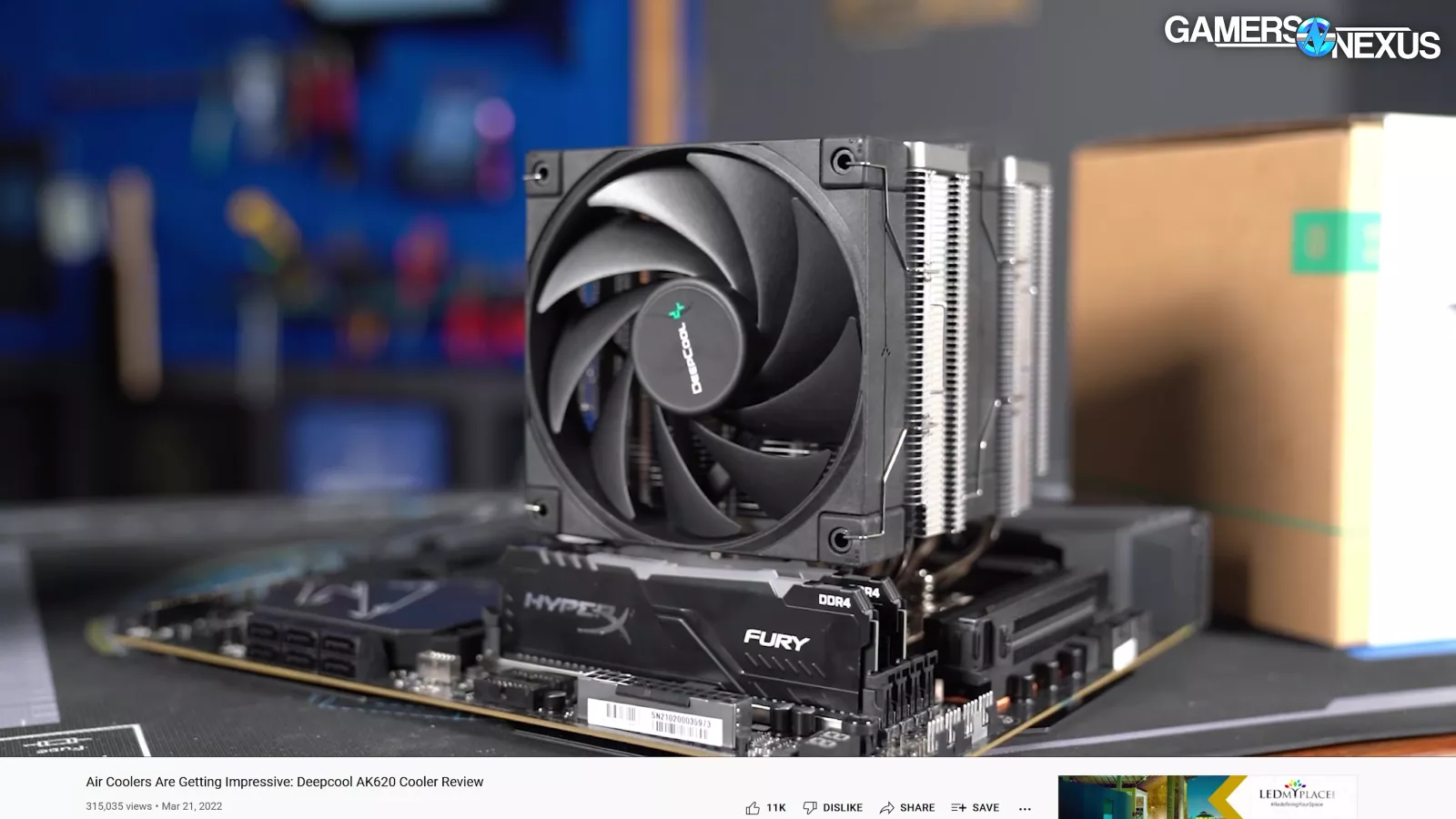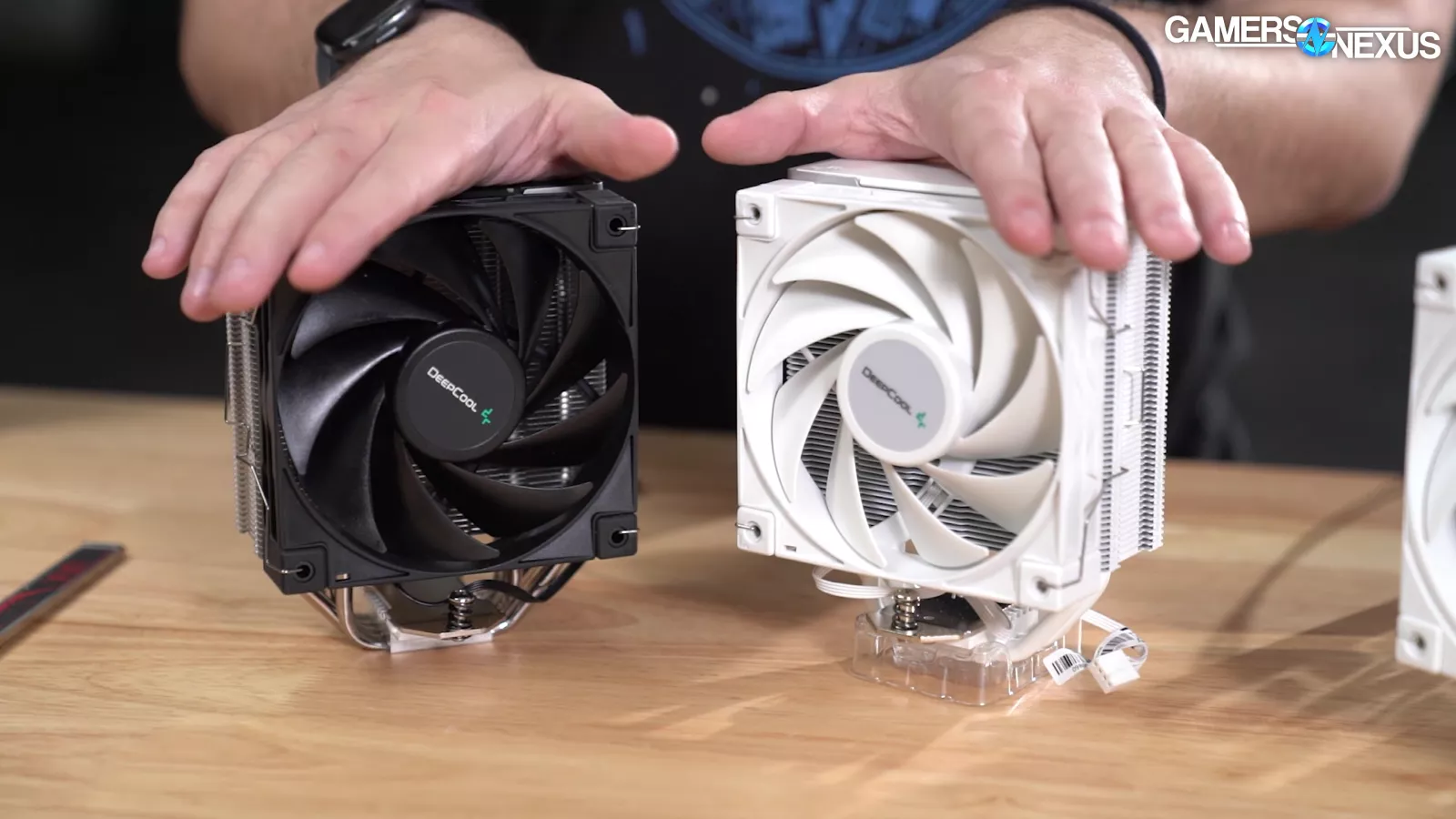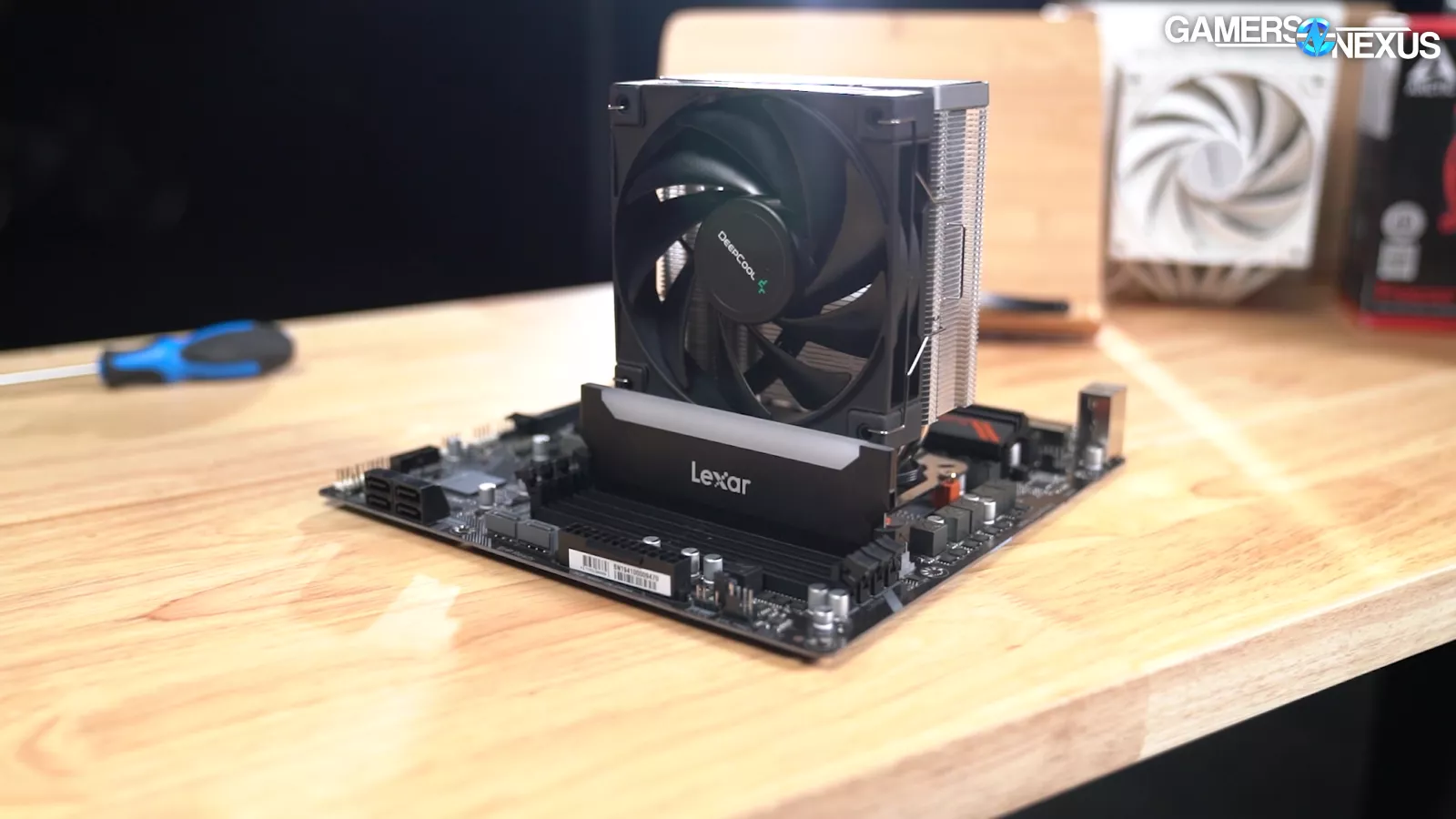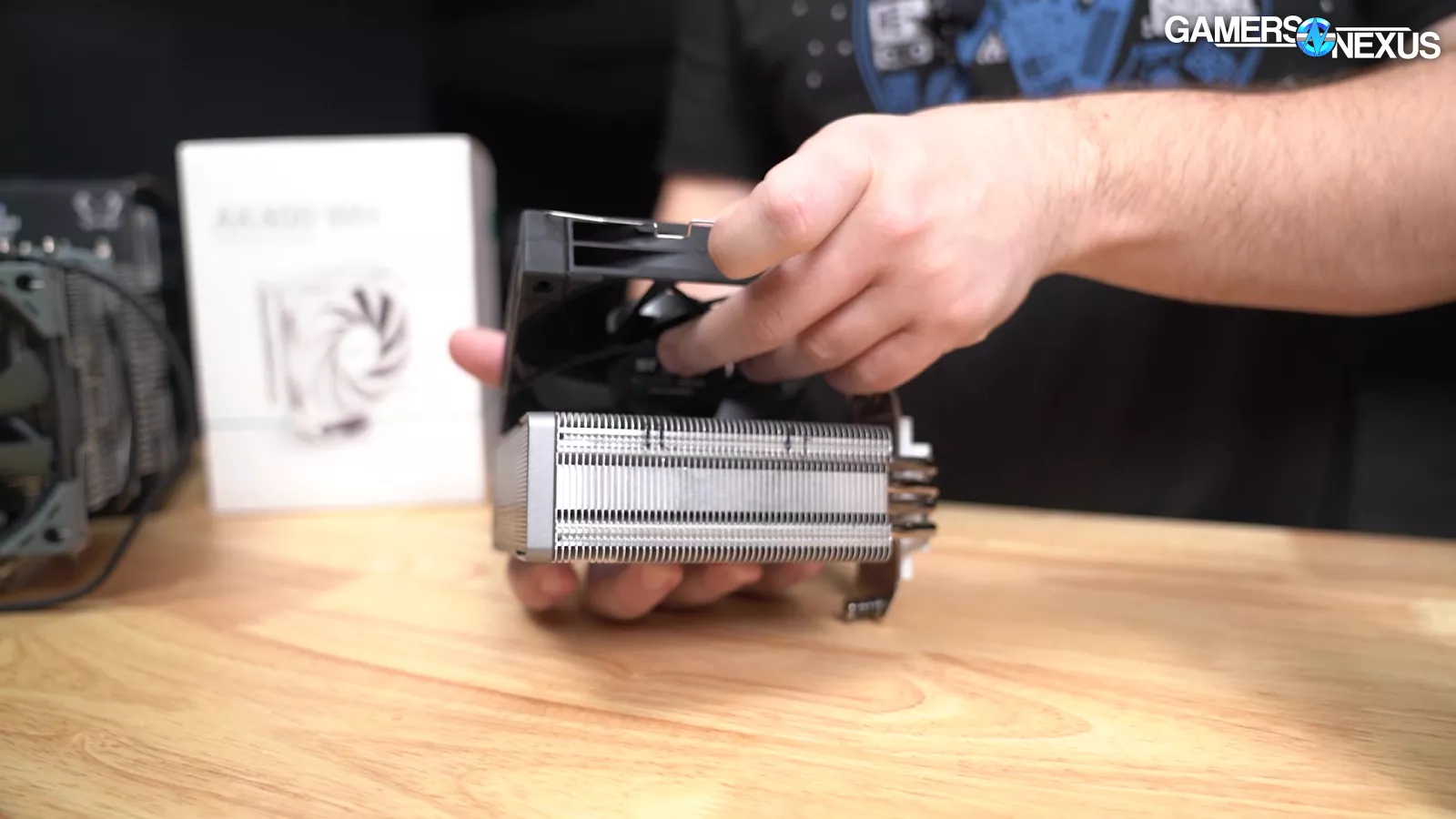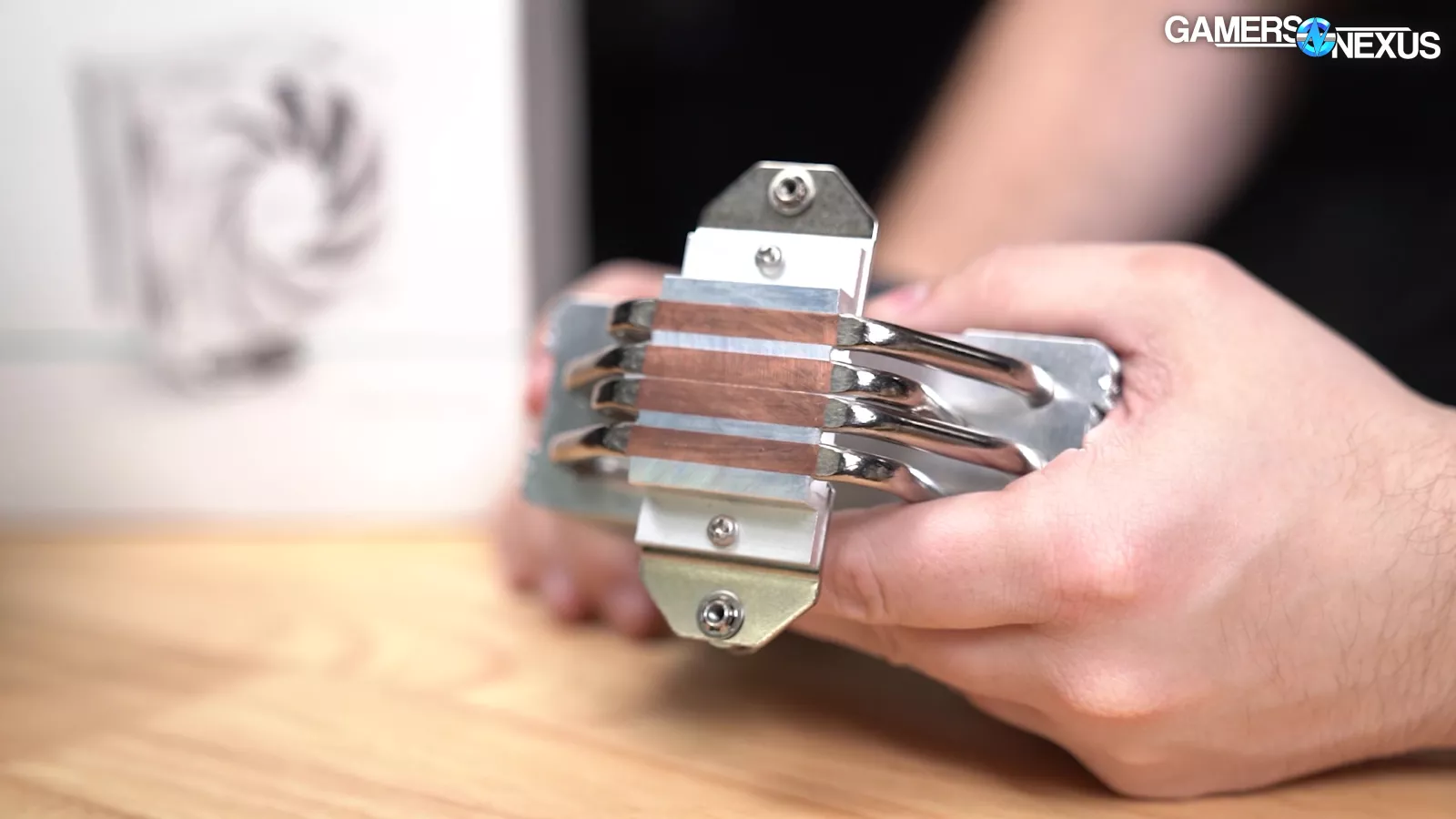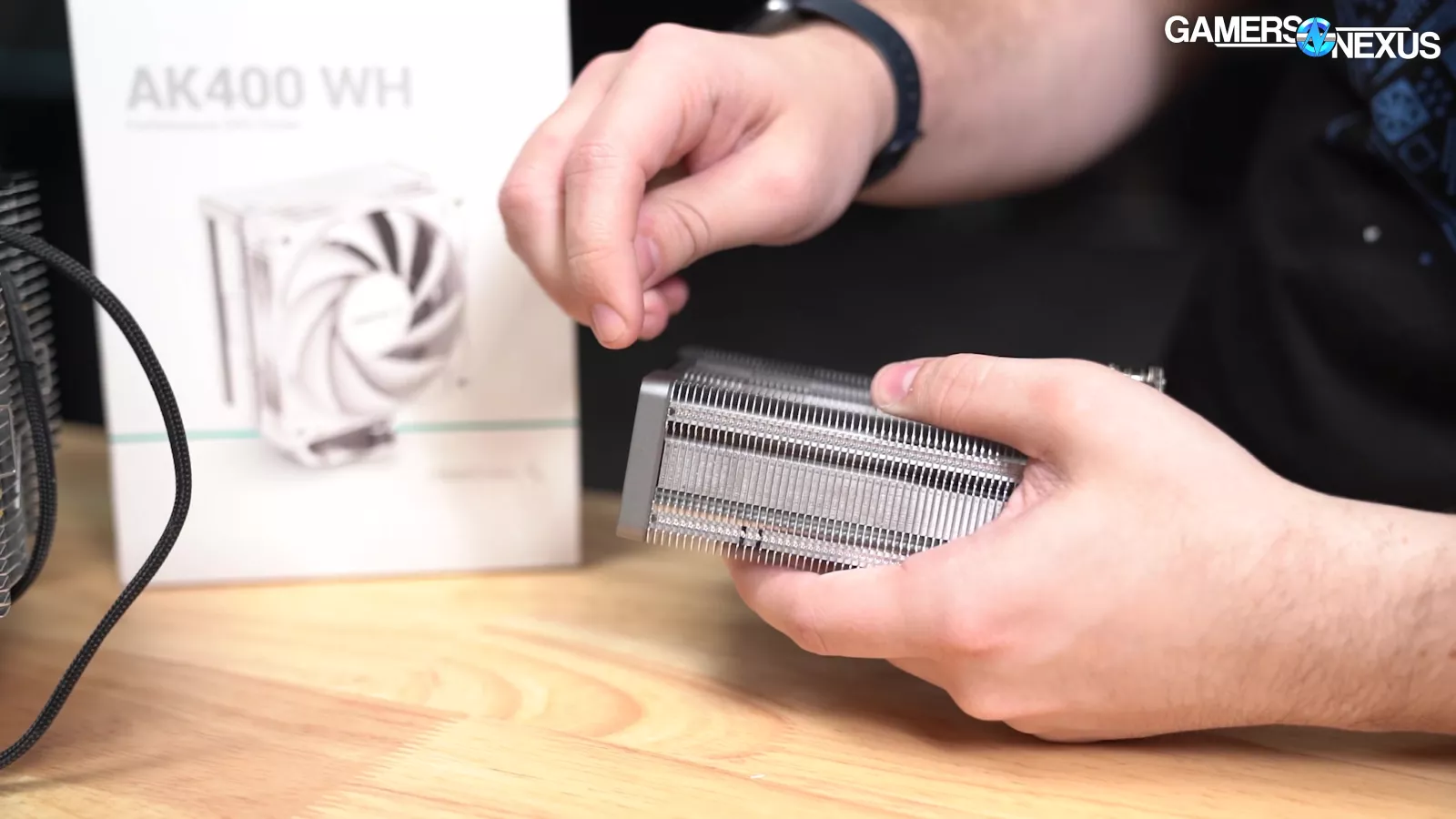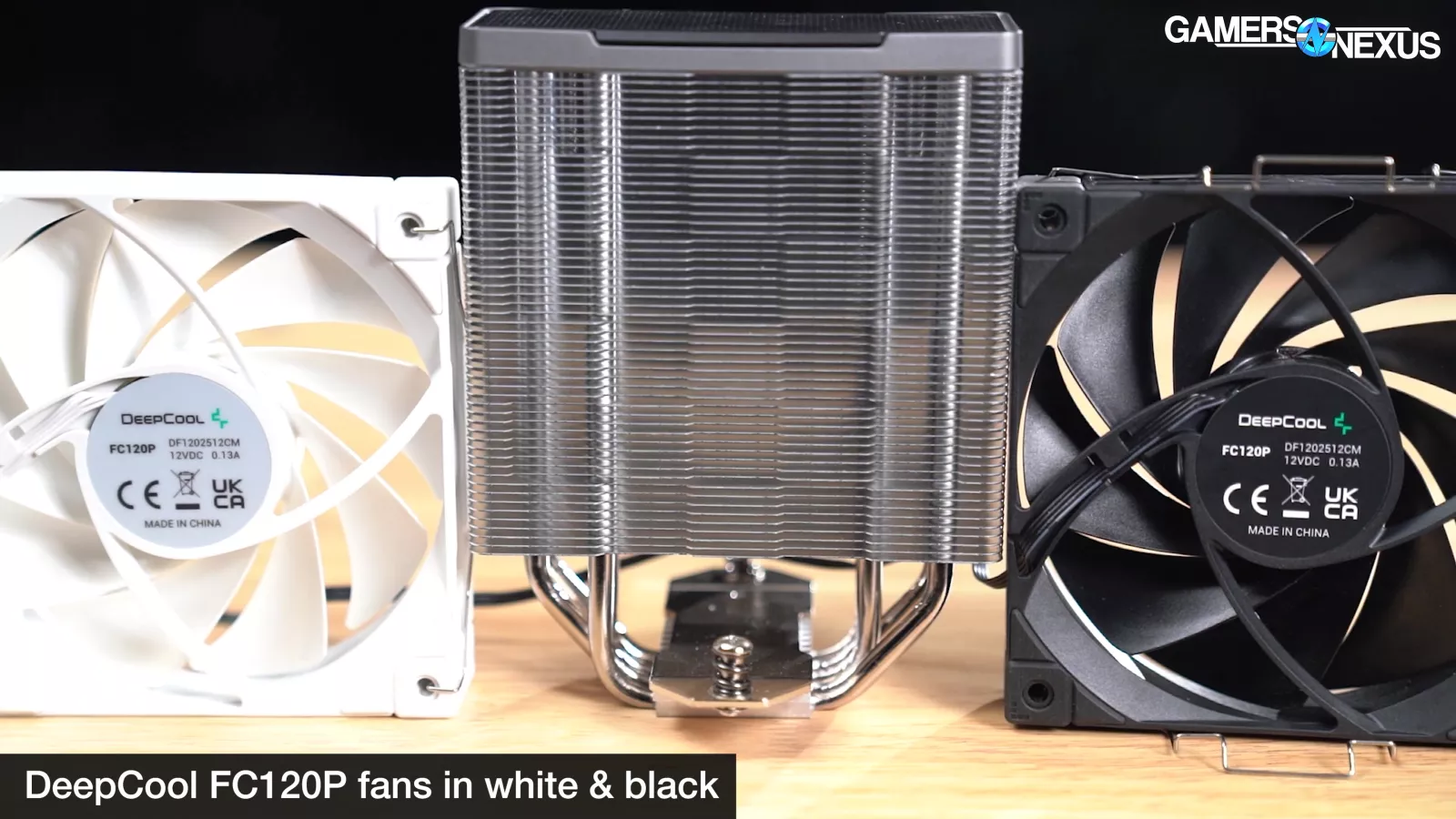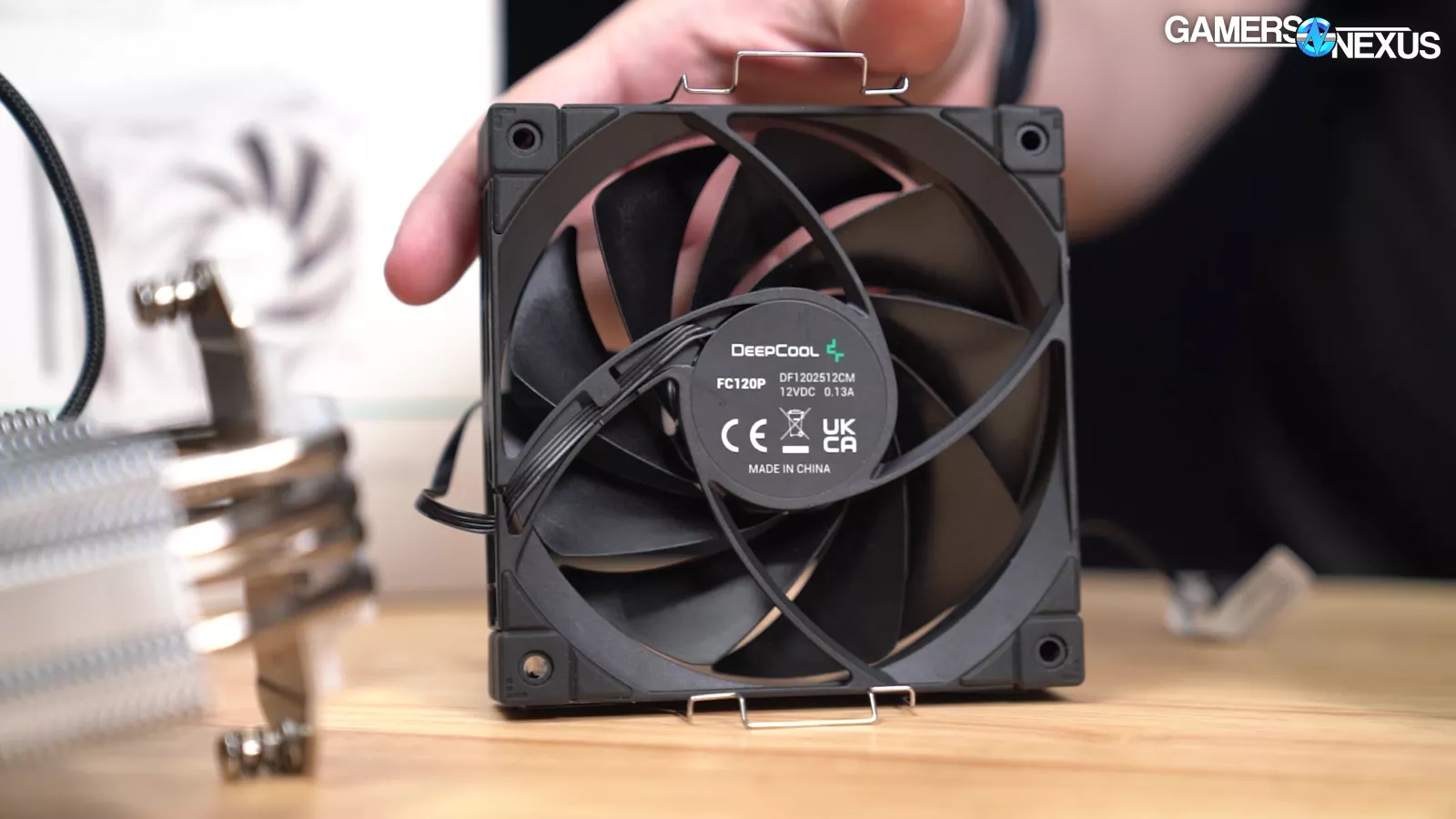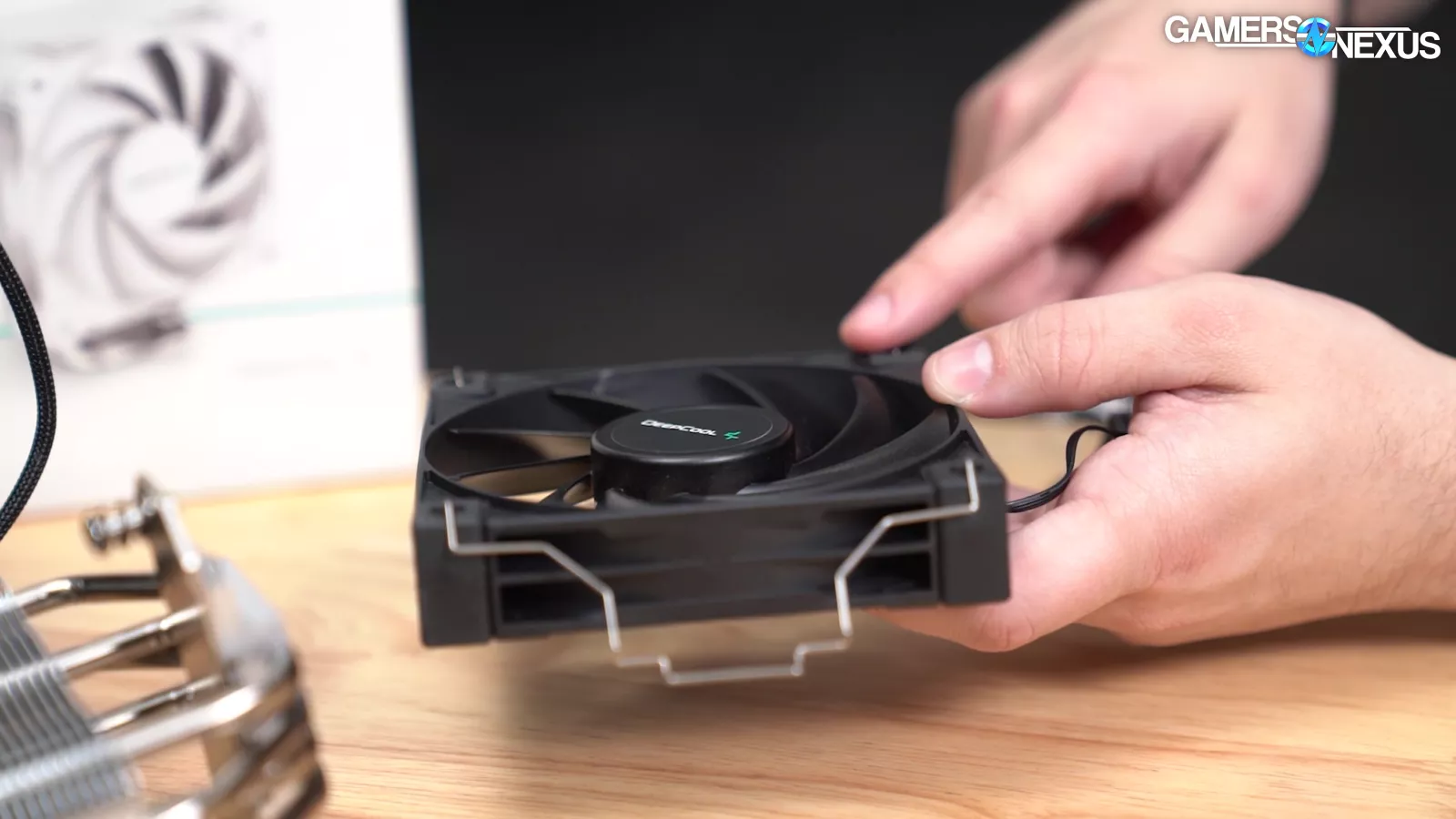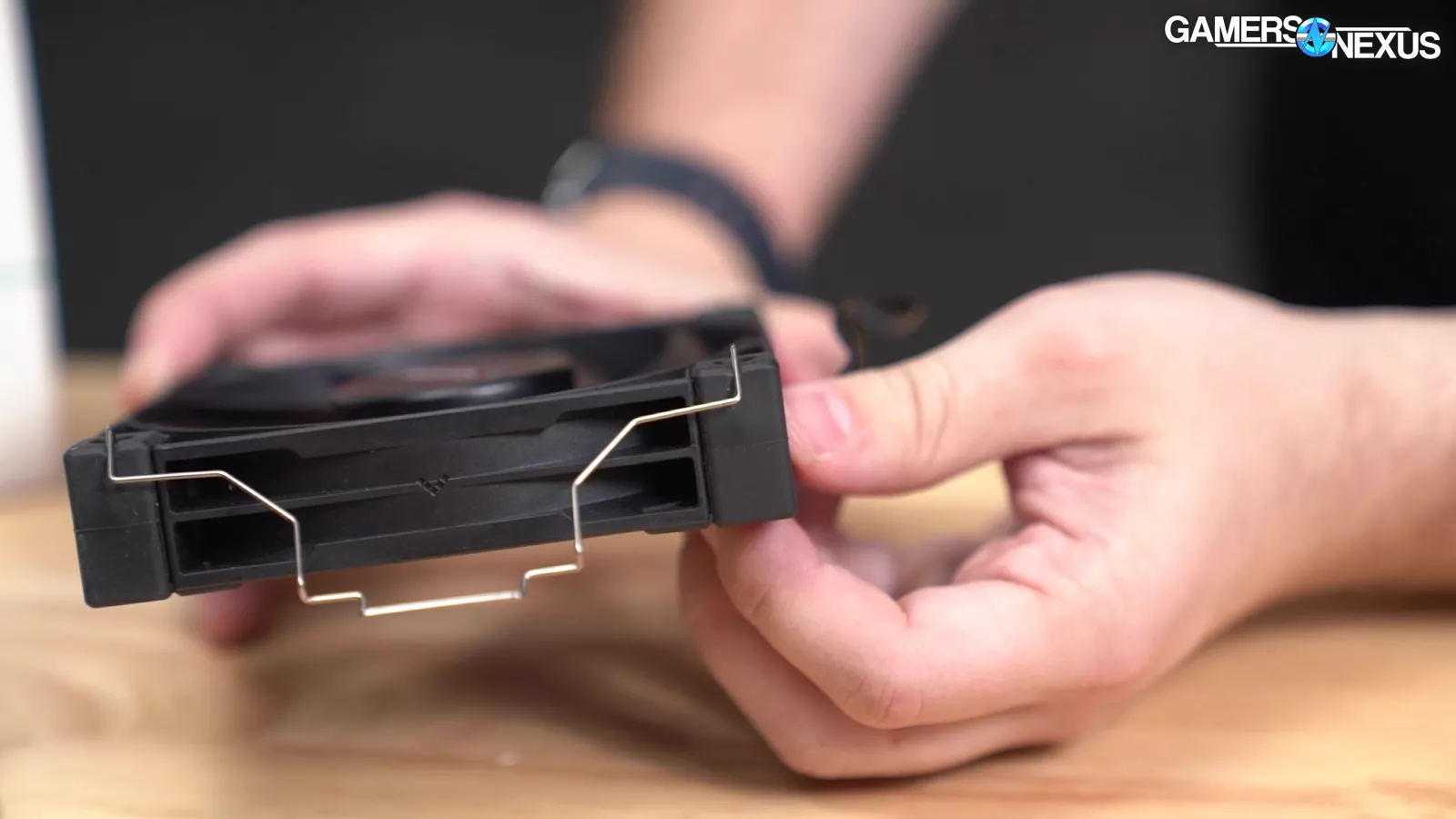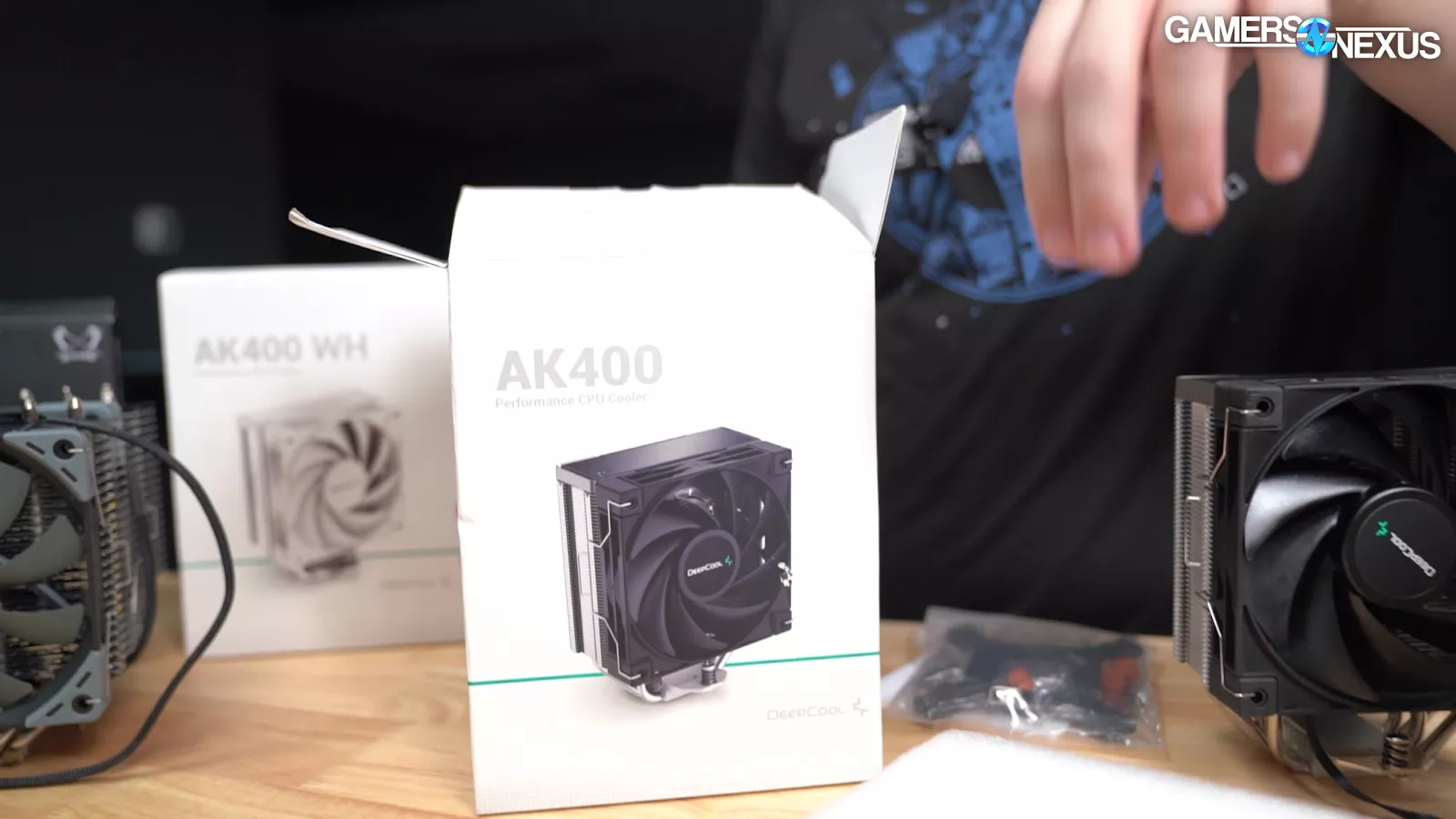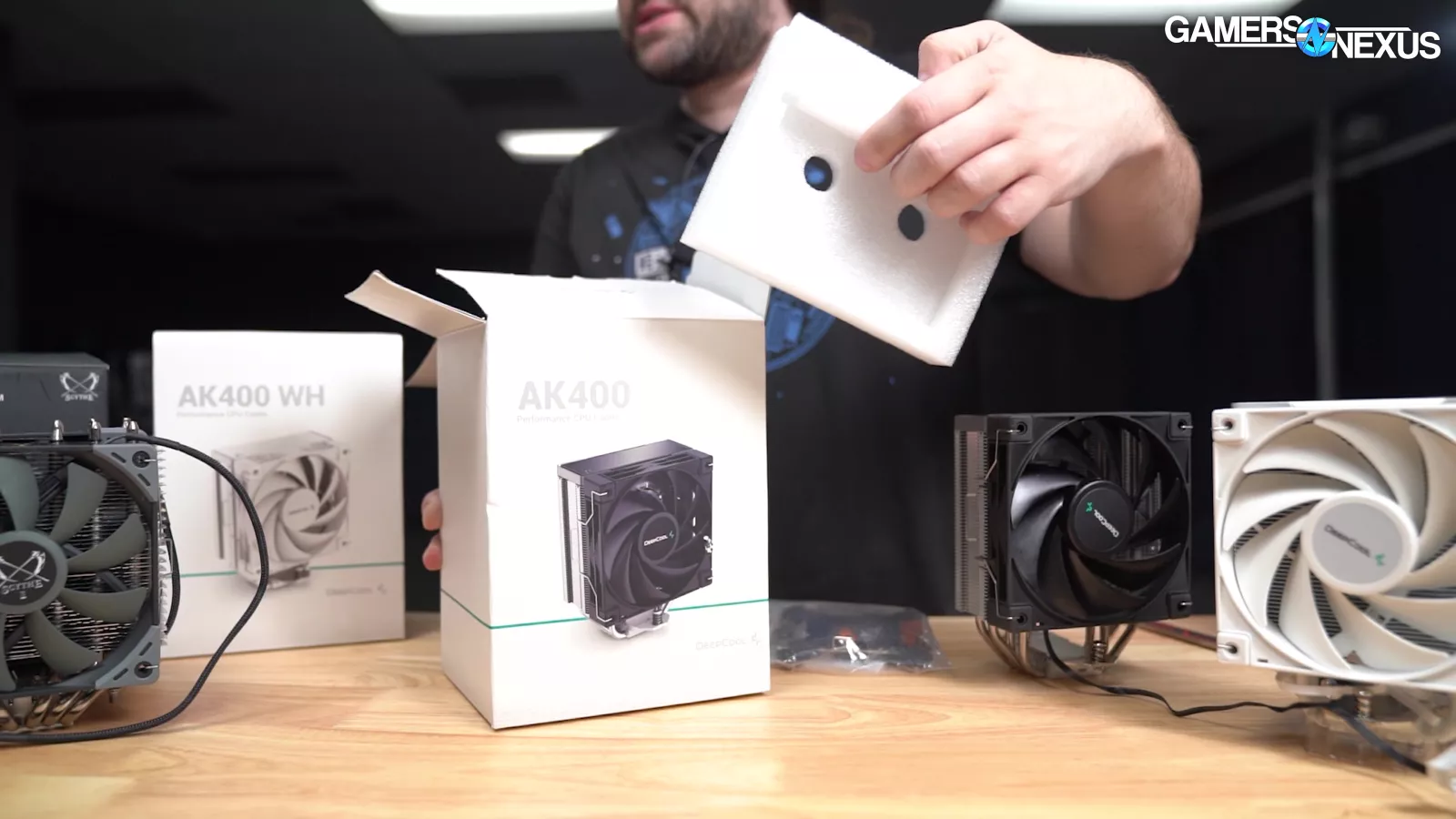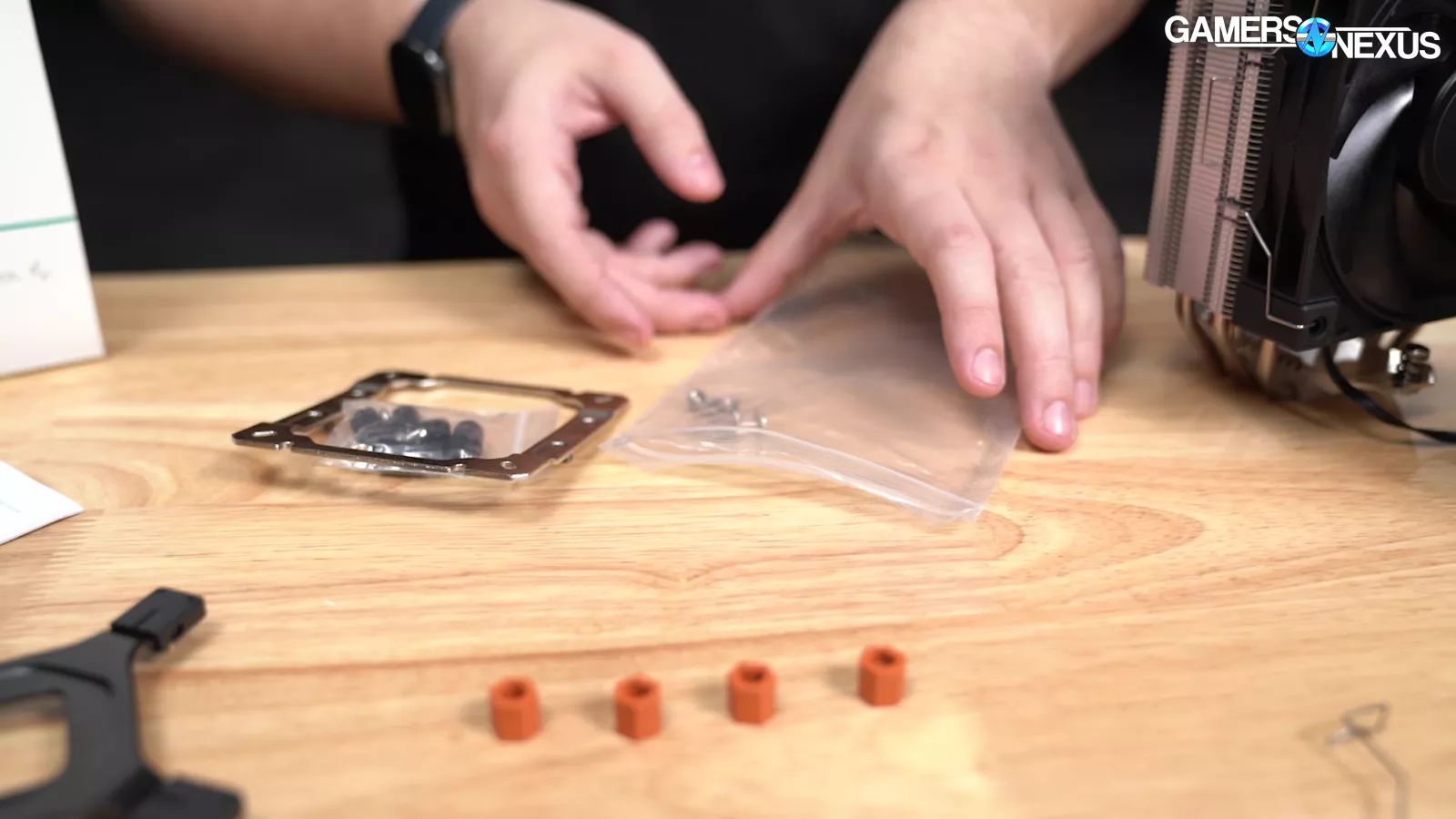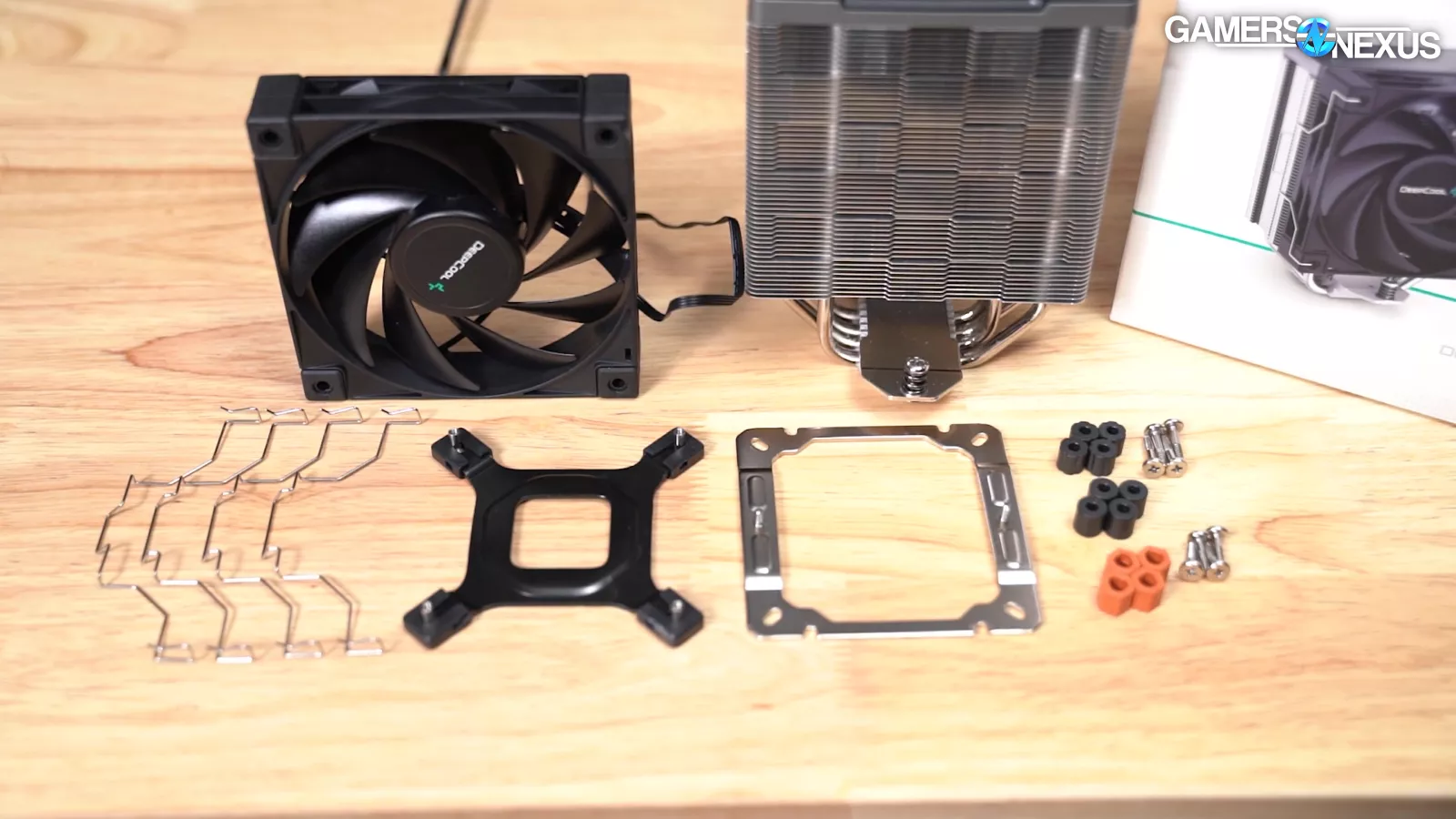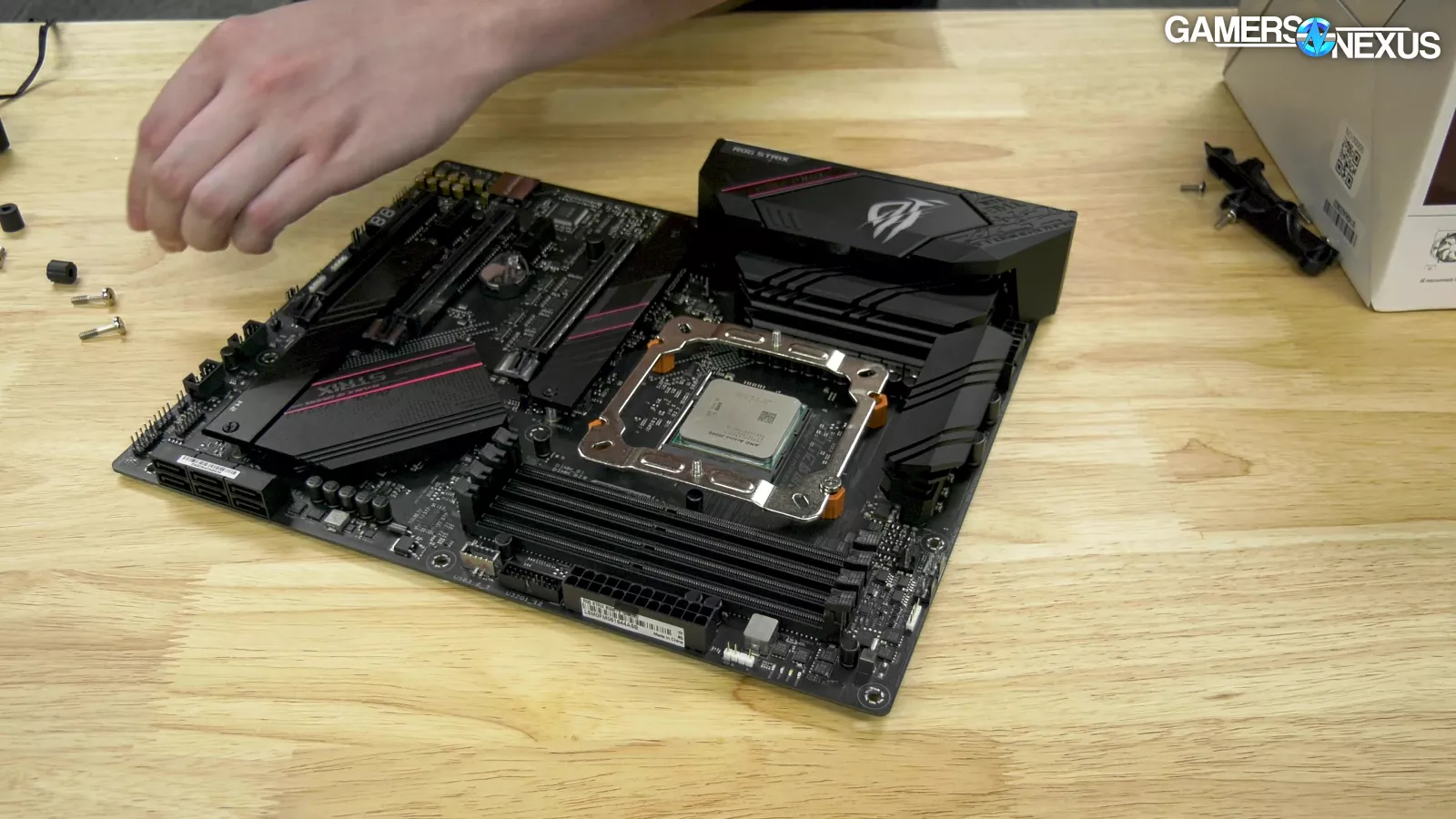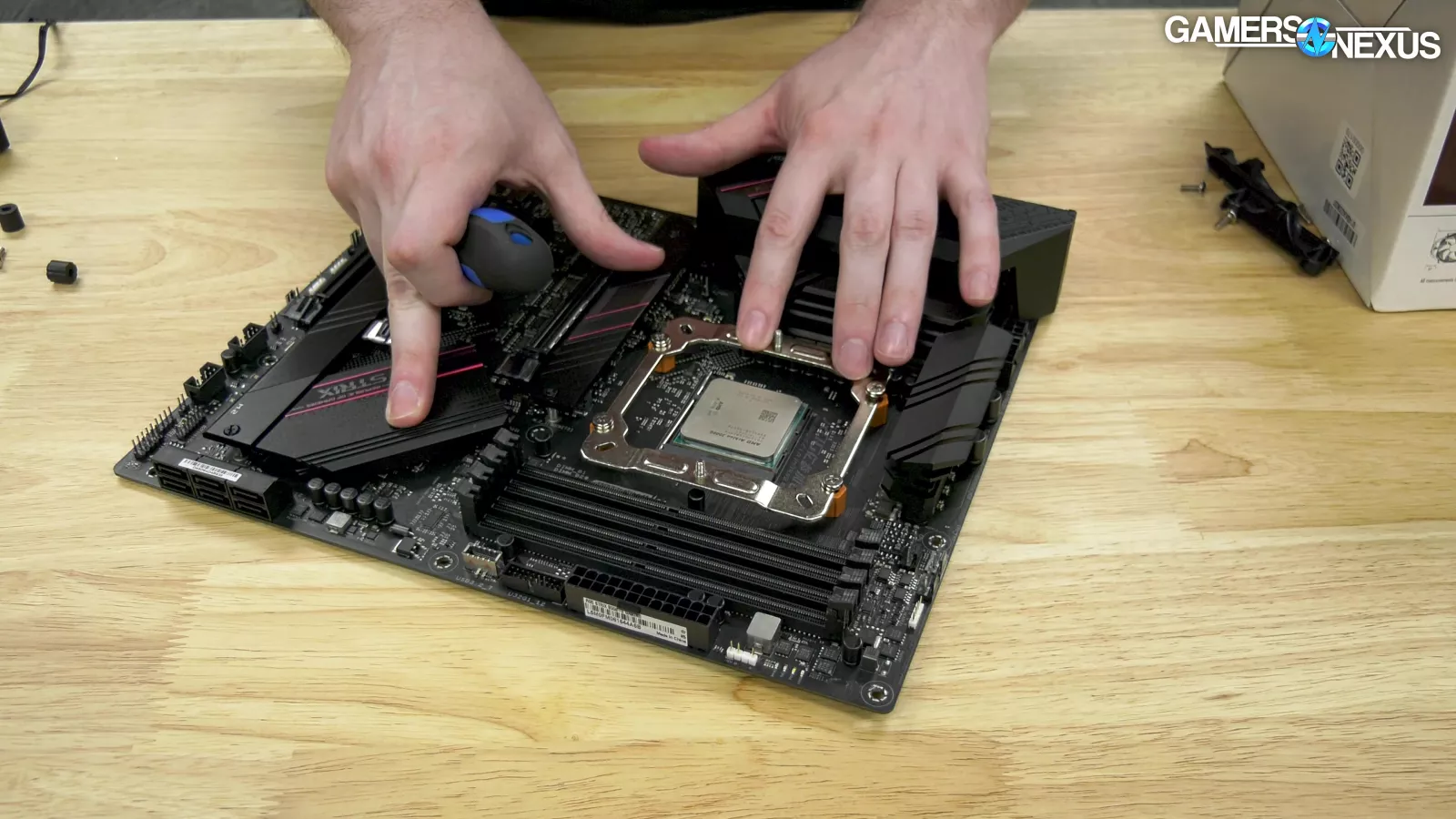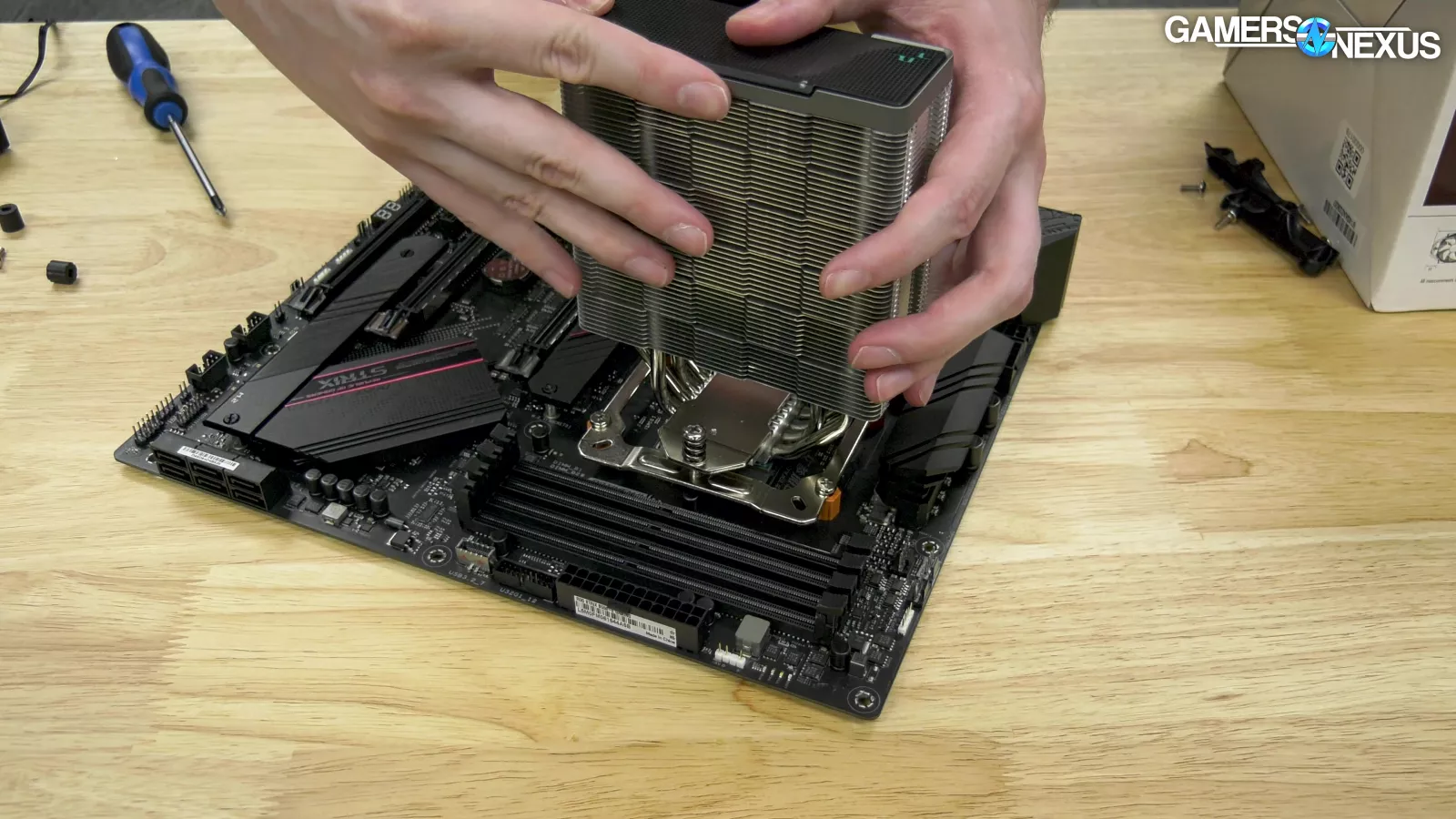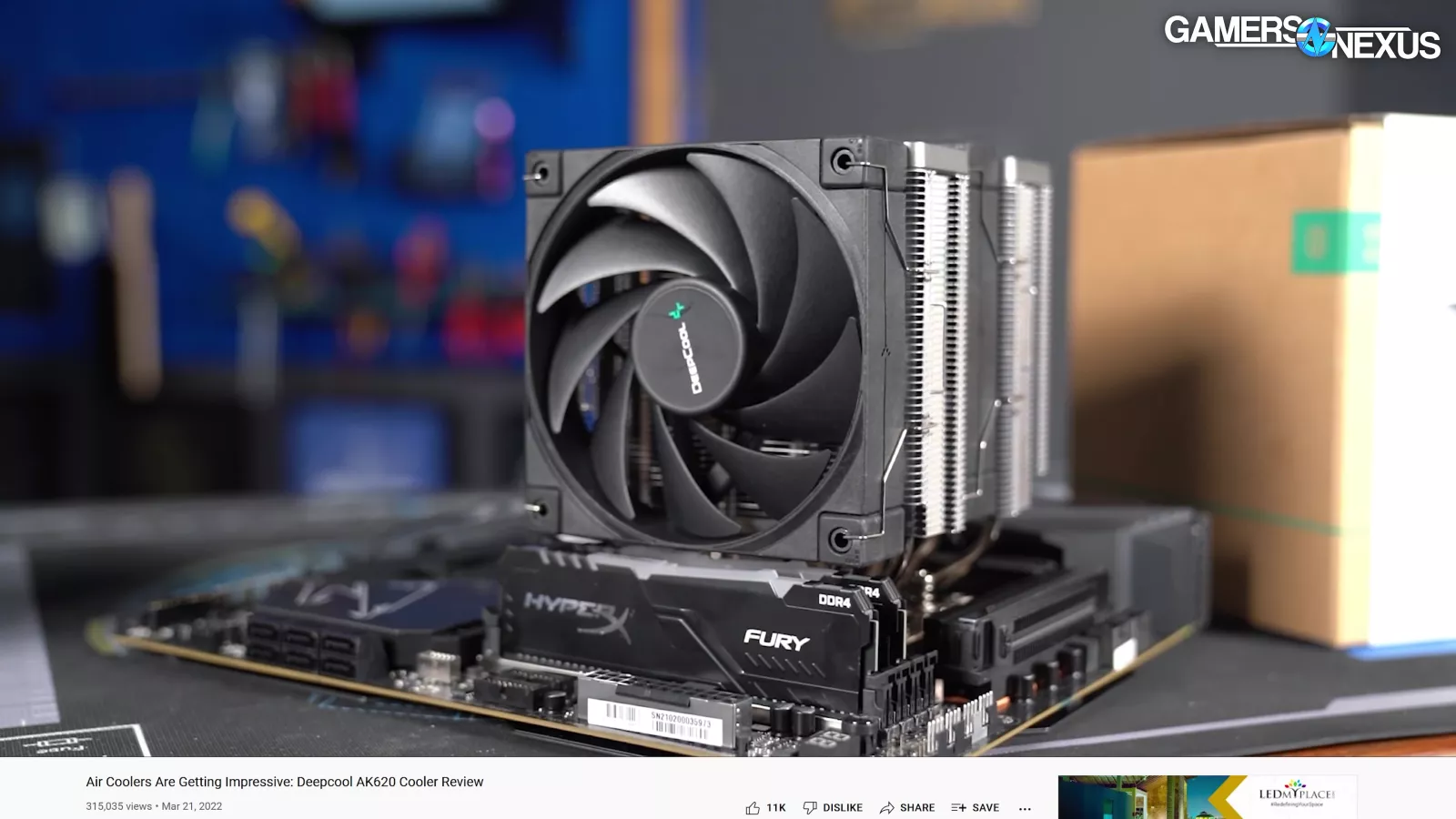
Best Cheap CPU Coolers Benchmarked: Deepcool AK400 Review
July 3, 2022
Last Updated: 2024-03-11
A reasonably priced, high performing 120mm single tower cooler with style
The Highlights
- 120mm single tower cooler with good build quality and strong performance for cheap
- Mounting kit is functional, but is an area of improvement
- Performance is commensurate with the price point and is competitive in the current CPU air cooler market
- Original MSRP: $35
- Release Date: January 11, 2022
Table of Contents
- AutoTOC

The DeepCool AK400
The air cooler market has actually gotten really exciting recently, and DeepCool and Thermalright have been pushing for a lot of that. We’ve reviewed coolers from both of them in the recent past. DeepCool we had some issues with a few years ago when we had to cut one of their heatpipes open to find that DeepCool had falsely advertised axial grooved heatpipes on the Assassin III when it actually used sintered heatpipes.
However, DeepCool has been on a roll recently with some better products. We reviewed the DeepCool AK620 cooler and it was fairly competitive. The Vetroo V5 set off all of this for budget cooler comparisons because it got a ton of momentum at its very competitive price point. It was commonly $30-$35, with the AK620 in the $50-$60 range.
So now we’re looking at the AK400, DeepCool’s new single-tower,120mm cooler. In this benchmark and review suite we’re going to be looking at thermals, pressure testing, and flatness of the coldplate for the cooler’s performance versus other competing CPU air coolers, alongside other scientific metrics we've taken.
During our original testing and filming of the AK400, we learned that the Thermalright Assassin Spirit had vanished from Amazon, which was one of our main comparisons to the AK400. It turns out that Thermalright had coopted its own listing to redirect people to the Assassin King.
Credits
Test Lead, Host, Writing
Steve Burke
Testing
Mike Gaglione
Writing
Michael Kerns
Additional Editing
Andrew Coleman
Web editing
jack reitman
The AK400 is a $35 CPU cooler, which seems to be about the standard price these days for an air cooler. There are some in the $20 range, but this is about where the price point is for brands that have some kind of name recognition and maybe a good warranty policy. And of course there is more to a CPU cooler than just performance. We also consider noise (the type of noise, the volume, cooling efficiency at a given noise level), warranty, and ongoing support.
For this comparison, the AK400 comes in two types - the normal model and white (there is no other difference between them, and supports all current socket types (LGA 1200, 115X, and AM4).
Best Budget CPU Cooler Alternatives
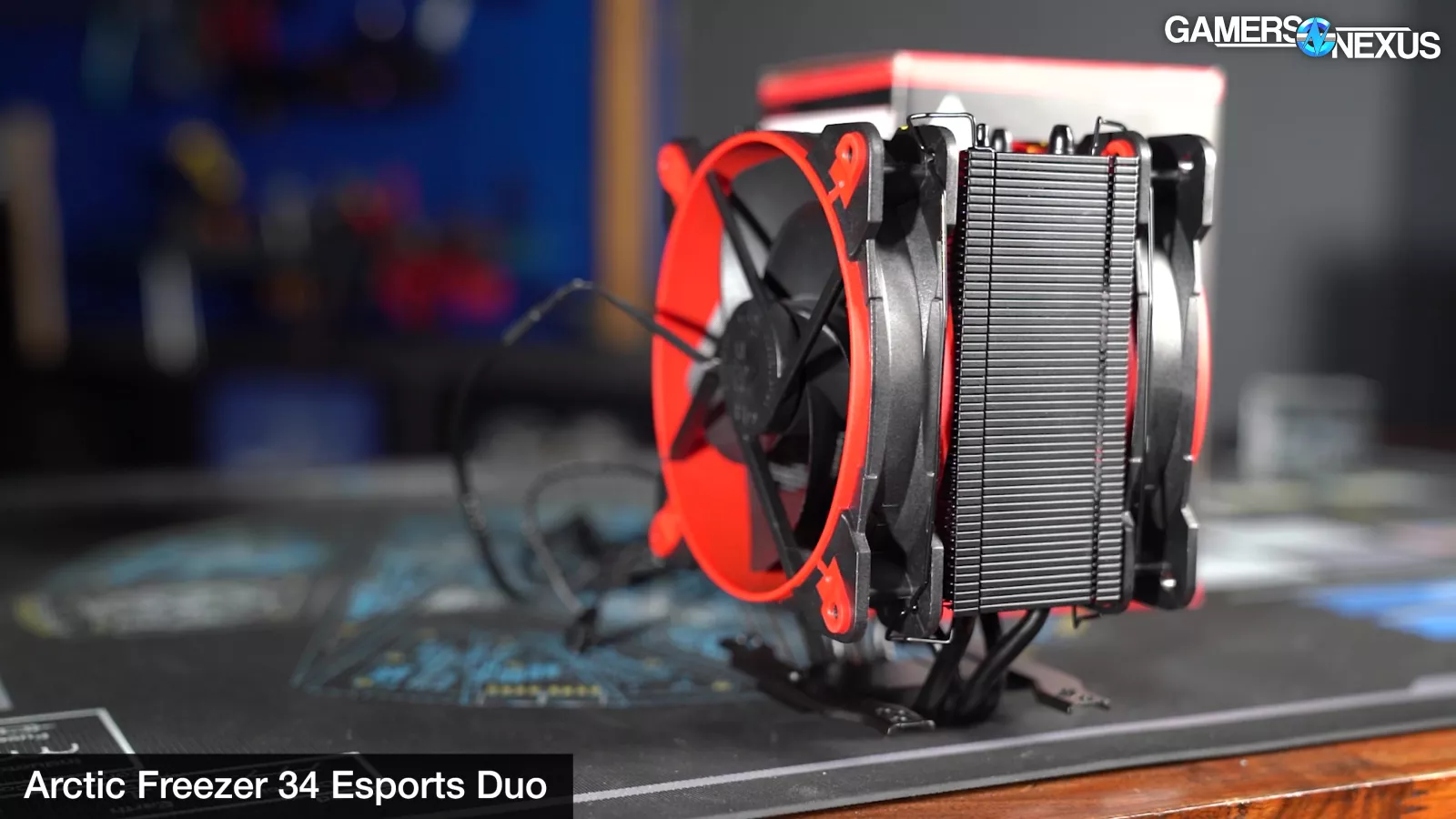
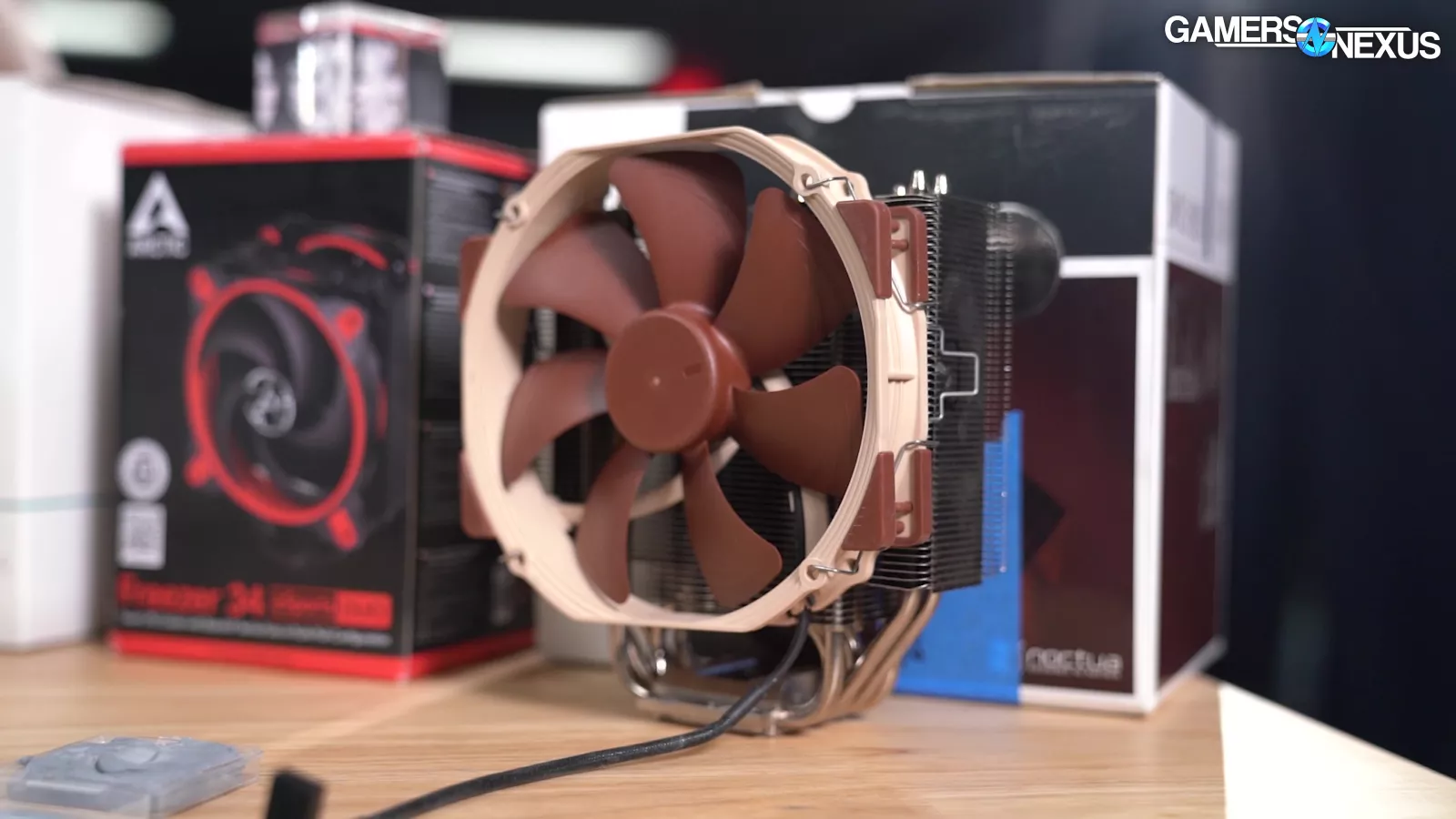
Noctua NHU-14S 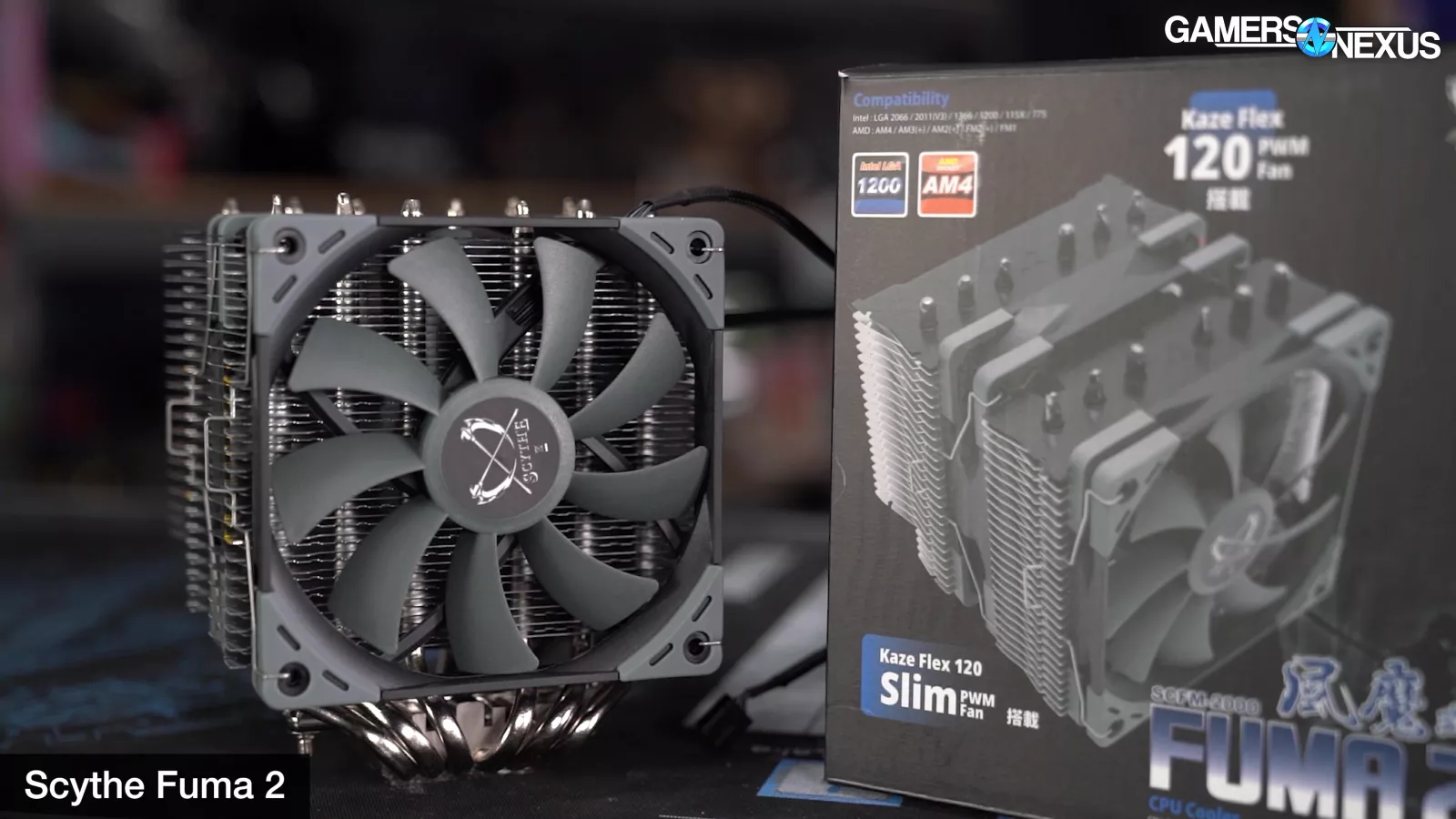
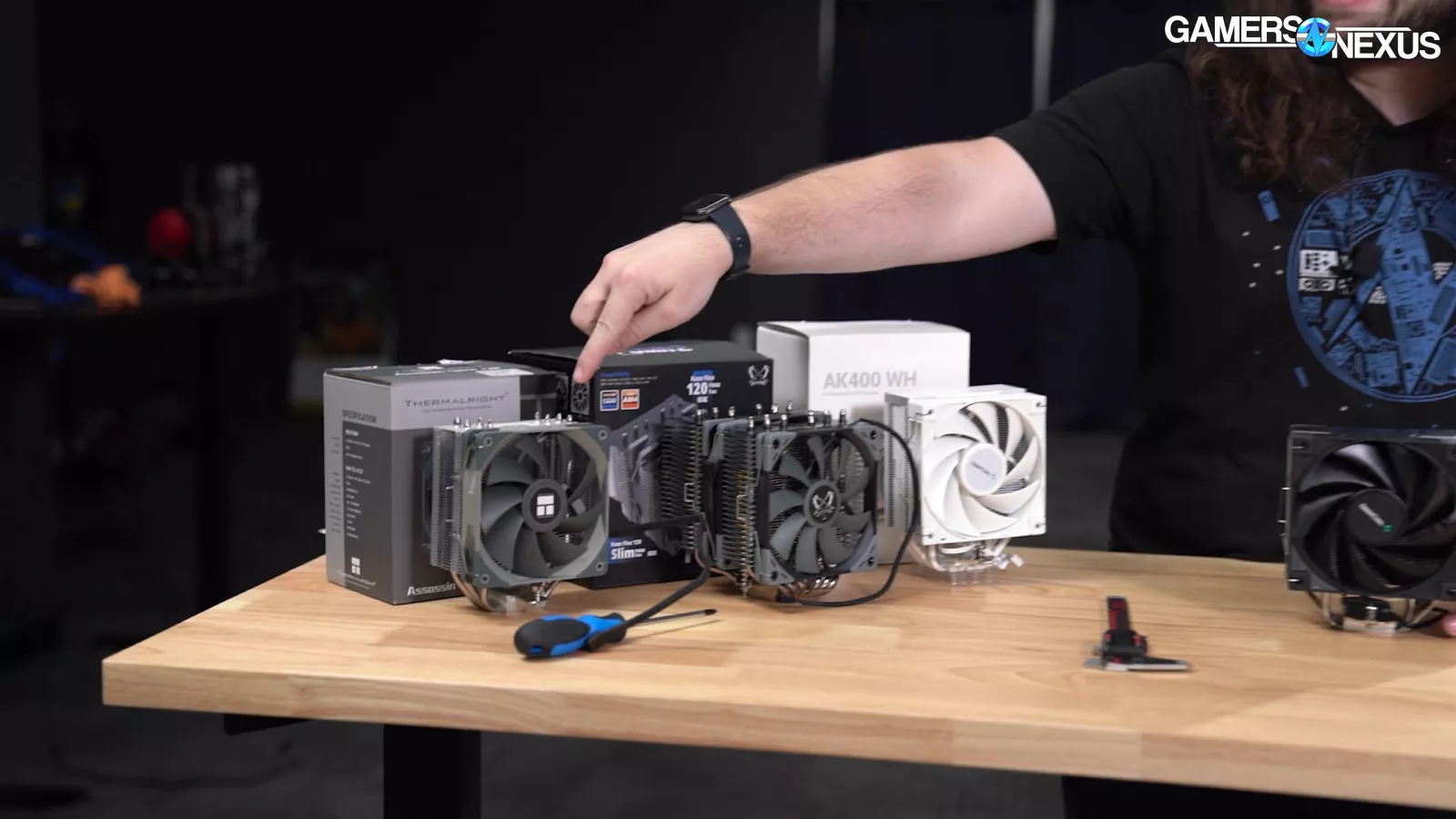
Thermalright Assassin Spirit 120 on far left 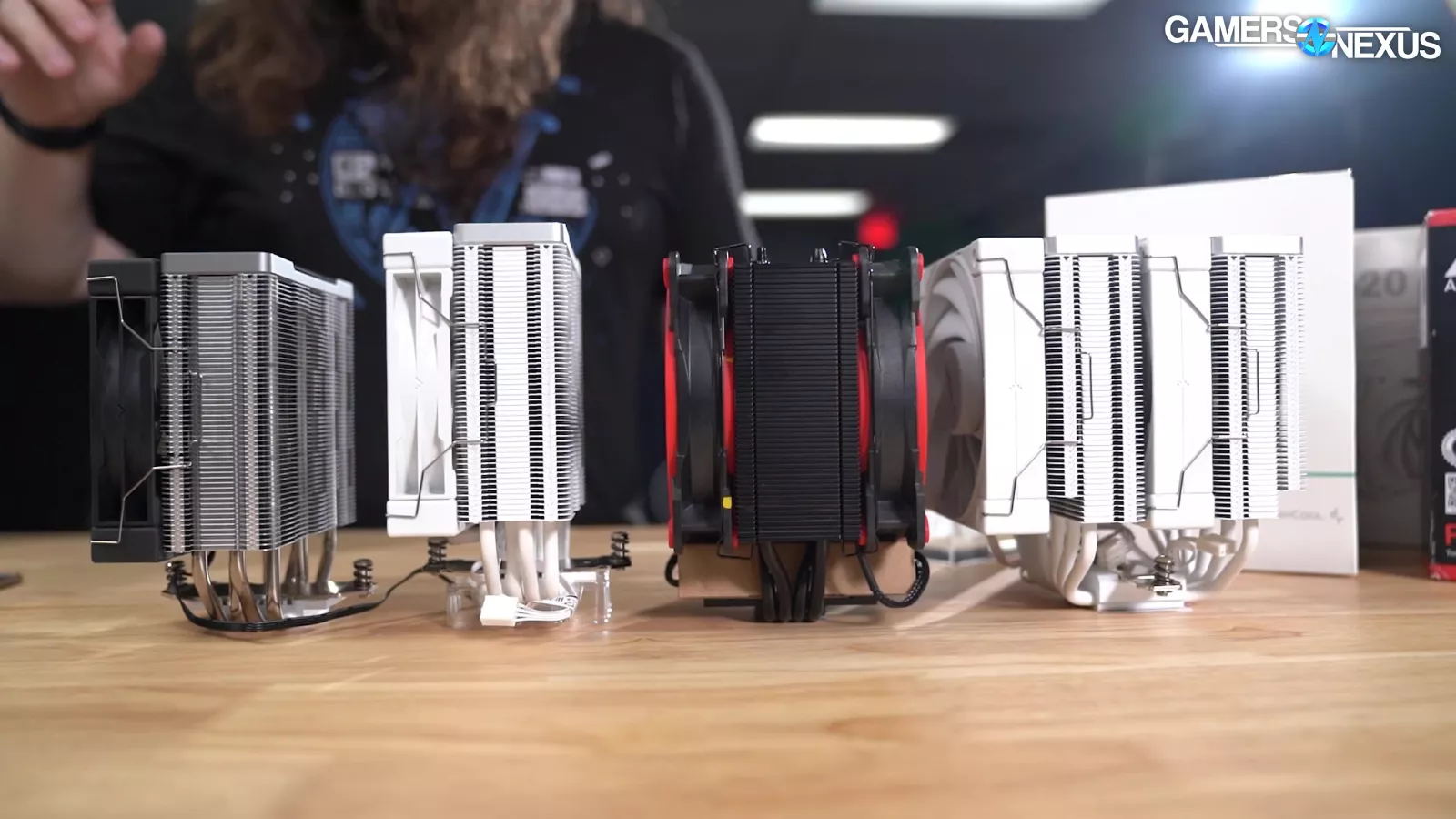
From left to right: Assassin Spirit, AK400, Freezer 34, AK620
One of the things we want to pay attention to as we go through the charts is the difference between something like the AK400 and something like the Arctic Freezer 34 Esports Duo, which previously did very well in our testing. The differences between them will become much more apparent as the heat load increases from 68W up to 123W, as that's when you start to see these pull apart a little more. At 68W, they look much more similar performance wise.
We also have the Noctua NHU-14S, DeepCool’s own AK620, and the Scythe Fuma 2, which is probably the most relevant cooler to really pay attention to. It’s more expensive than the AK400, but this is the best acoustic to thermal ratio we’ve looked at at really any time recently, other than larger liquid coolers that are large, which is worth considering if you can stretch the budget a little.
But at around $35, the main comparisons are going to be between the AK400, AK620, 34 Esports Duo, and the Assassin Spirit.
Mechanical Design
The AK400 has a separable 120mm fan mounted by standard wire clips, which allows you to attach a second fan to the other side of the cooler with the extra clips included in the mounting hardware. The fin stack itself is made of standard aluminum, but the heatpipes are embedded in the coldplate such that they make direct contact with the IHS rather than having the coldplate wrap around and encompass the heatpipes.
The naming of the AK400 is an indicator of how many heatpipes it has (4). If you look at the AK620, it has six heat pipes, so it appears that the third digit in the model number indicates the number of heatpipes in the cooler.
DeepCool is utilizing an interesting checkered pattern on the fin stacks that we’re pretty sure in marketing they would argue has some sort of thermal or acoustic benefit. Realistically, there is no way to actually prove that - you could maybe simulate it in software, but for all intents and purposes this is just cosmetic. Additionally, the top of the cooler has a plastic cap that can be removed which will give you an extra two to three millimeters clearance.
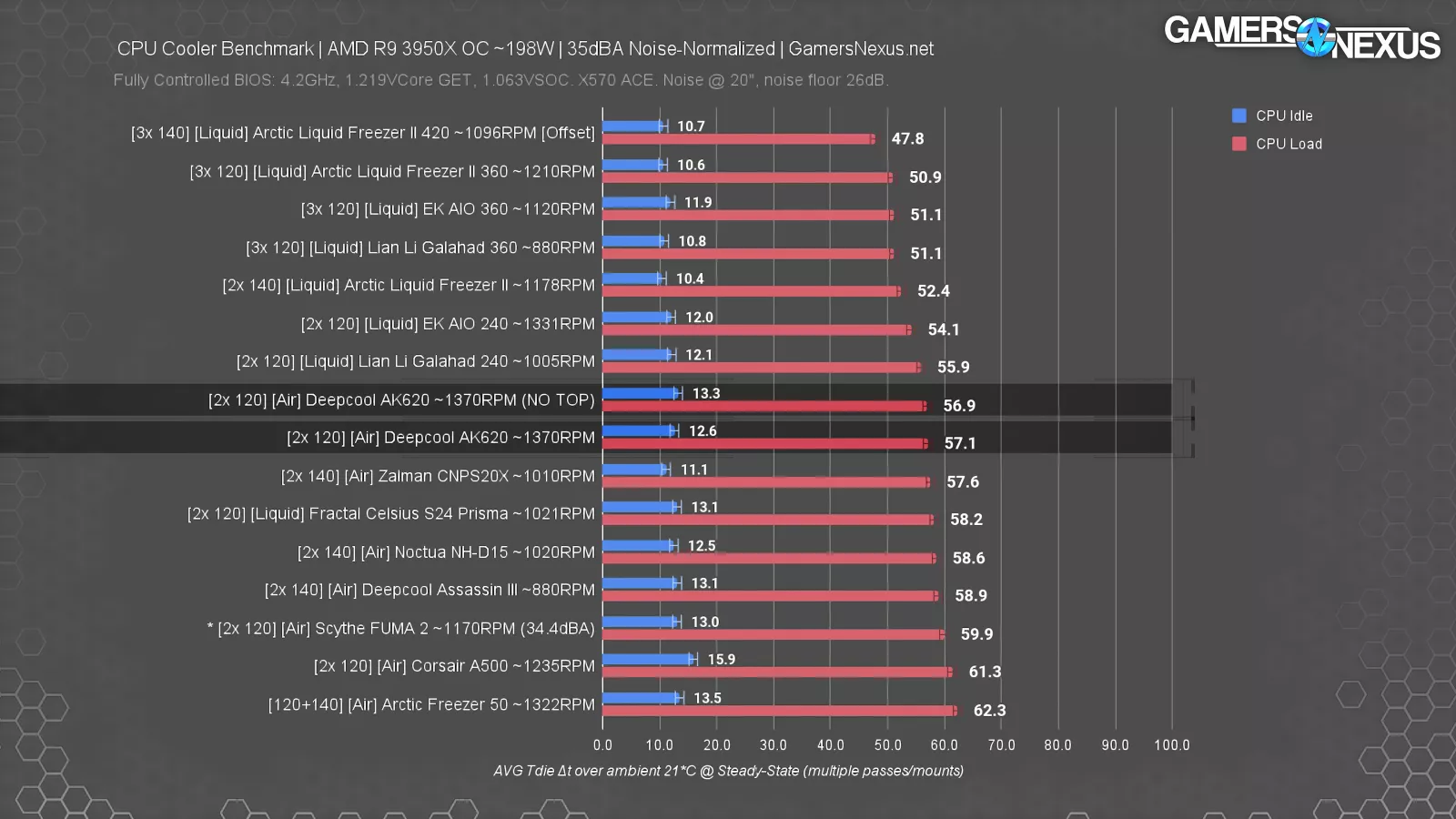
The only reason it is not more (because the cap is clearly thicker than 3mm) is because the heatpipes stick up out of the fin stack and get encapsulated by the plastic cap. We’ve done testing in the past on the AK620 with this cap on and off for both of the towers and it did not have a meaningful impact on thermals, even though it is “capping” the top of the heatpipe where you have some natural heat rise coming off of it, so the aesthetics are not taking away from the thermal performance, which is good.
Fan Design
If you look at the fan at a glancing angle, you’ll see that it’s concave towards the hub with the blade design. This is another one of the small fan design features where we’ll see how it does in thermal testing, but it’s just a small deviation from how some of the other vendors have designed their fans.
The corners of the fan have small blocks of rubber wrapped around the plastic border - you’ll see these on most fans (Thermalright, Scythe, and Noctua to name a few). For example, the standard Noctua approach is to do these rubber corners that you can replace for different color variants. The point of the rubber corner covers is that it keeps the plastic housing of the fan from contacting the actual heatsink while the rubber does contact the heatsink. This allows the rubber to absorb vibration and reduce the noise that would be generated by the operating fan rattling against the heatsink.
As for the fan type, this is a new fan from DeepCool - the FC120P. It is a 0.13 amp fan at a standard 12 volts and has a max RPM of 1850. The fans on the AK620 are FK120, rated at 0.12 amps at 12 volts with an RPM difference as compared to the FC120P.
Dimensions & Case Compatibility
The AK400 itself is approximately 120mm wide (as you would expect because it has a 120mm fan), and 155mm tall, which may lead to some fitment issues on certain mid-tower cases that cap out at 150mm for CPU cooler height. You can take off the plastic cap for a few millimeters of extra clearance, but if you have to do that you’re throwing away part of the actual value of the cooler.
For width with respect to clearance, you're not going to be in the RAM socket area of basically any motherboard - you won’t have to raise or lower the fan to clear anything, except maybe certain mini-ITX configurations. If you look at the actual depth of the mounting screws on the base versus the fan, the fan itself does not go that far past the screw.
Packing & Mounting Hardware
The packaging on the AK400 is very simple - it ships in a standard white box with a picture of the cooler on the side. Internally, they’ve packed the cooler in a foam block (top and bottom of the cooler) with a plastic protector sheet for the coldplate, which is again direct contact heatpipes. DeepCool hasn’t gone overkill with a ton of plastic and waste, but they also haven’t skimped on it too much.
The included mounting hardware comes with spare fan clips if you want to add a second fan (this is not super worthwhile based on the thermal results, but it is available). The hardware is packaged in reusable plastic bags which we like to see as it is less waste overall instead of a bunch of single use plastic, provided of course that you have a reuse purpose for those plastic bags. The cooler also comes with a physical manual as well as the online option.
Installation Instructions (AMD & Intel)
Let’s quickly look at installation.
AMD installation uses the stock AM4 backplate, after which the 4 included standoffs are placed over the backplate’s own standoffs. Next, the Deepcool bracket gets screwed into the backplate through the standoffs. This utilizes the central 4 of 8 total holes in the bracket, which is designed universally for use on AMD and Intel. For AMD, the more center-of-mass screws shift some of the force further inward, which reflects in pressure testing momentarily and also in the “wiggle factor” (which is the scientific metric) for the cooler moving around.
At this point, two cap screws in a mounting plate below the tower get threaded onto screws in the universal bracket.
Intel installation is almost the same, except it uses an included Intel backplate and the retaining screws move to the outer holes.
The system is easy enough and we don’t have too many complaints from an ease of installation perspective, but we did find that it’s more difficult to restrict the cooler’s side to side movement when fully mounted than on some competing product designs. This can be compensated for, but it's just something you need to be aware of. Deepcool’s mounting hardware and retention kit are among the poorest aspects of an otherwise competitive product in the AK400, and we can show why in our first test.
Pressure Scanner Results
First up on our tests is the coldplate pressure scan. This test uses chemically reactive materials and a special NIST-traceable scanner to measure the distribution of pressure across the CPU’s IHS. This test evaluates the design of the coldplate and mounting system and how effectively they work together to hold the coldplate to the IHS.
This test was made possible through all of our supporters on Patreon and those who buy merch like toolkits, mouse mats, shirts, and other items from our GN store. Thanks to all of you for making what we do possible.
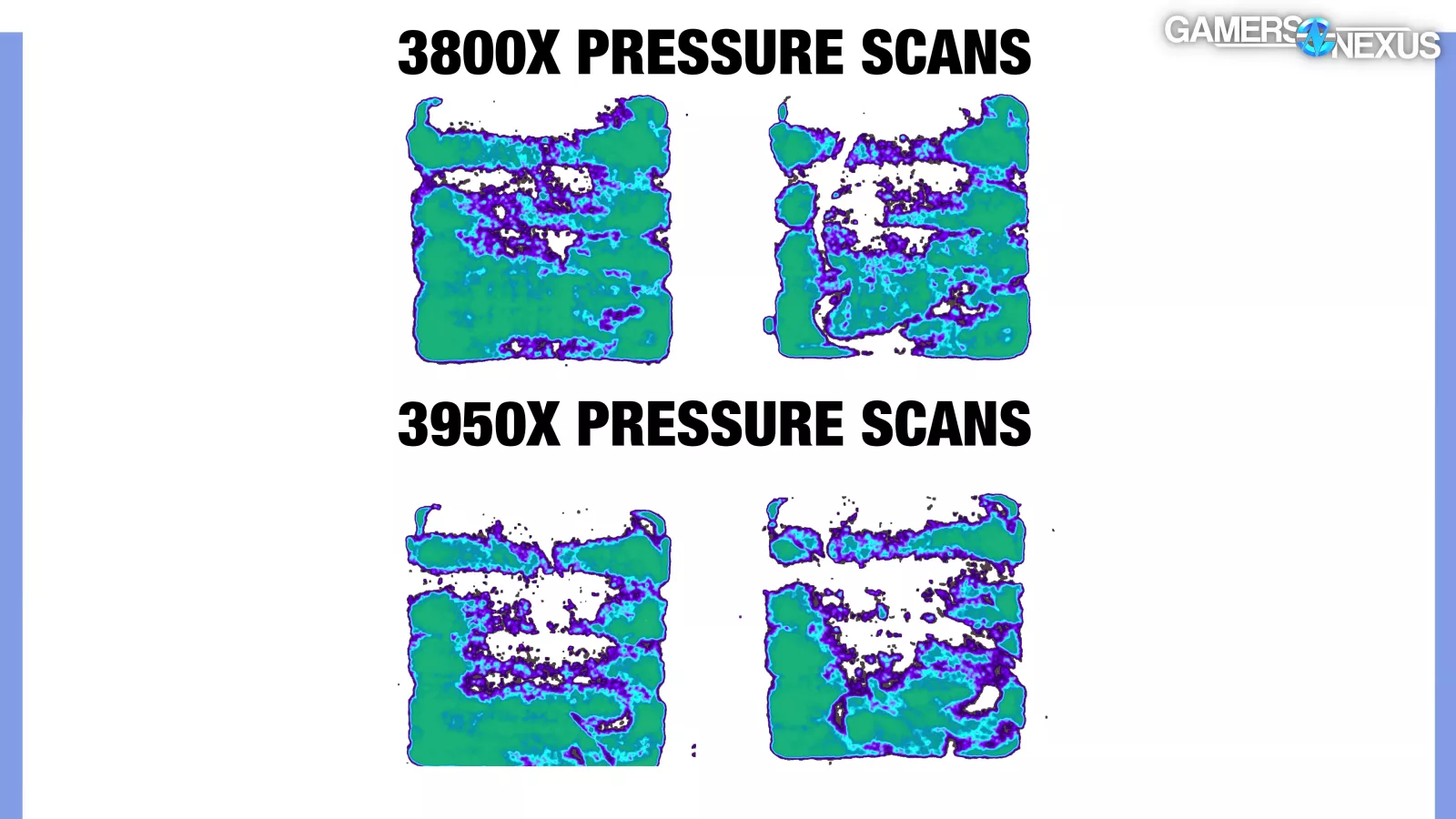
The AK400 mounted to our 3800X shows weak pressure centrally overall and clear outlines for the heatpipes. Contact around the outer edge is good, but most of the heat generation will be dead center. Thermal paste will fill this gap, and low pressure doesn’t necessarily mean no contact, but there is performance left on the table here.
The 3950X mount shows mostly the same: It’s lacking pressure centrally and along the edge nearest the I/O, but we’ll need thermal tests for more.
Coldplate Surface Flatness
Our surface flatness testing is next, using even more specialized testing equipment in our test lab. This tests the actual consistency of the coldplate surface as it mates with the IHS. This bonds well with the pressure testing to form a full picture of the contact quality.
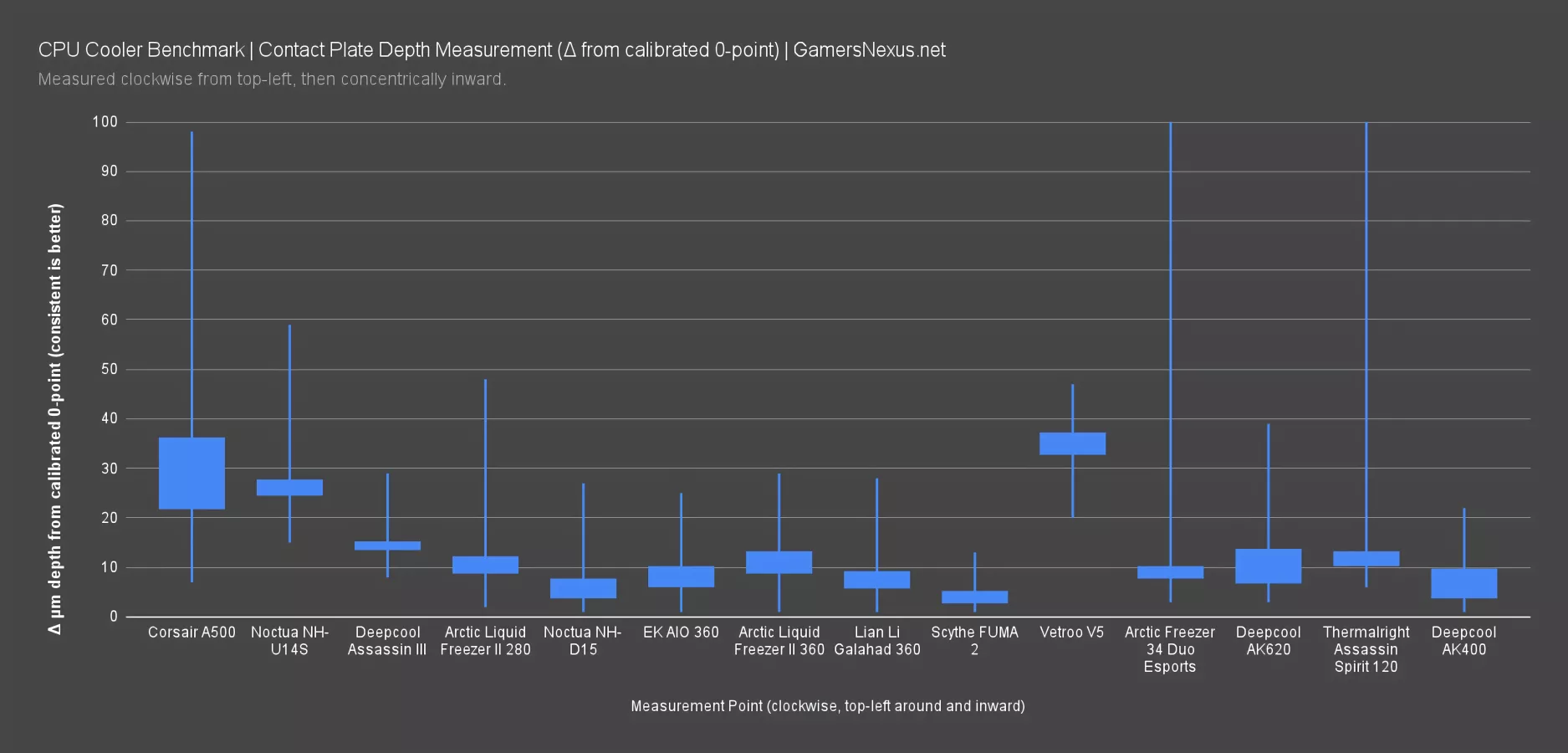
The AK400 has poorly distributed pressure, as we saw before, which is a result of its somewhat wobbly mounting hardware. The flatness is good, though: It’s about the same as everything else here and doesn’t encounter the massive outliers we saw on the Assassin Spirit or Freezer 34 Esports Duo. This helps to make-up for the lacking central pressure on the AK400, and flatness is especially important when heatpipes are directly exposed. You need those heatpipes to make good contact with the IHS, otherwise you just don’t have good cooling potential.
The pressure map and the flatness testing/chart are what make our cooler reviews some of the best on the internet because you get the full picture of what really constitutes the thermal performance of a given cooler.

CPU Cooler Test Bench
| Part | Component | Provided By |
| CPU | AMD Ryzen 5 3600 - Used for lower ~68W heat loads for small coolers. AMD Ryzen 7 3800X (2 chiplets active) - Used in all cooler benchmarks. AMD Ryzen 9 3950X (3 chiplets active) - Used for higher heat loads to show scaling on big coolers. | AMD |
| Motherboard | MSI X570 MEG ACE | GN Purchase |
| RAM | GSkill Trident Z Royal DDR4-3600 CL16 | GSkill |
| GPU | EVGA NVIDIA GeForce GT 1030 SC (passive cooler, second slot down) | GN Purchase |
| PSU | EVGA 1600W P2 | EVGA |
| OS | Windows 10 | GN Purchase |
68W 35dBA Normalized Benchmark
Starting off our performance tests, we’re taking a look at our 68-watt overclocked 3600 with each cooler set to a normalized noise level of 35dBA. We explained this in our in-depth testing methodology piece previously: This test is designed to test the efficiency of each cooler and provide an even playing field by using a consistent noise level, disallowing brute force. We will be testing max cooling performance next. This heatload is representative of R5, i3, and i5 CPUs. As a reminder, each cooler uses its included fans for all our tests.
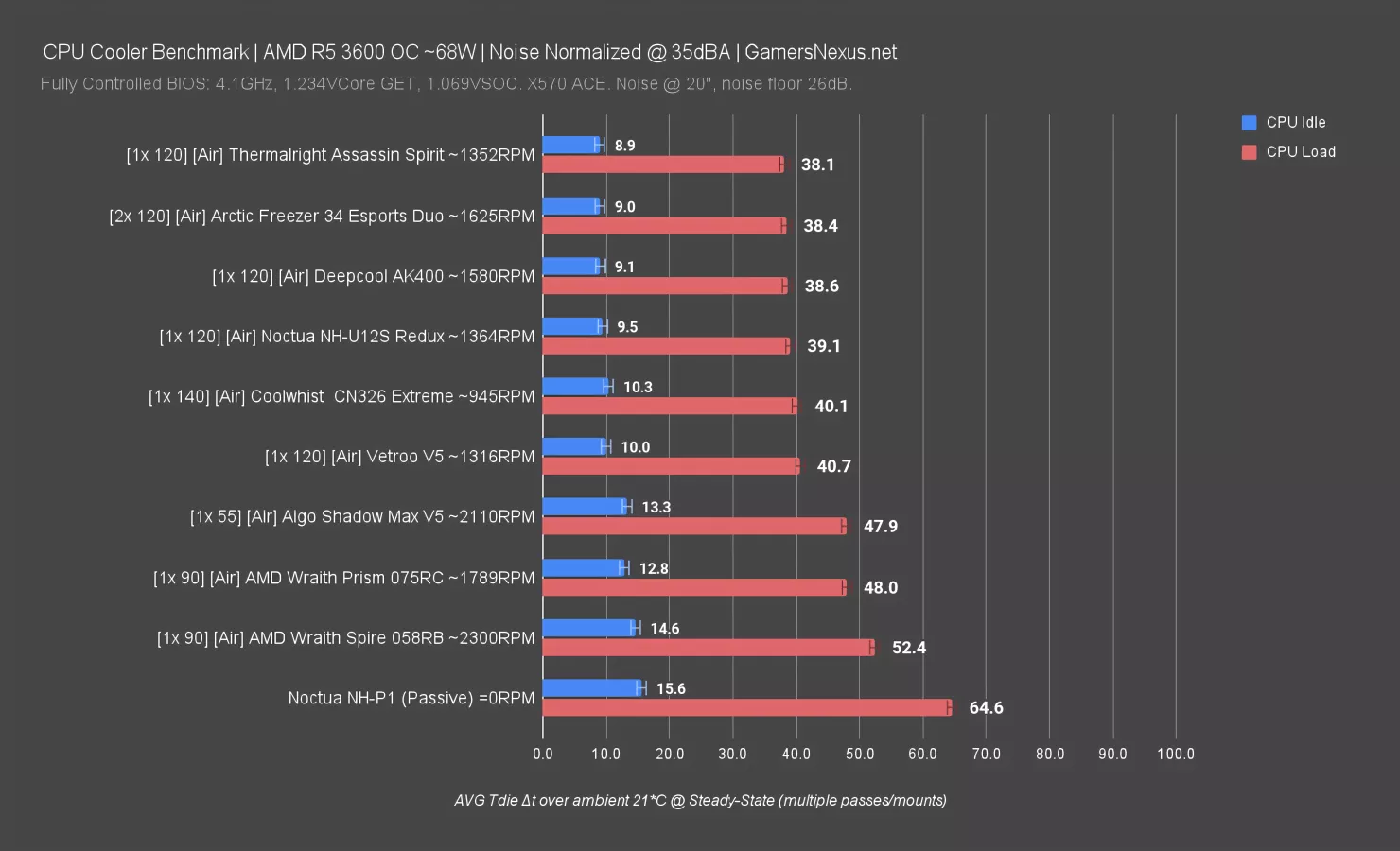
Here’s the chart. At 35dBA, the AK400 runs the CPU at 39 degrees Celsius over ambient. This places it within error of the Arctic Freezer 34 Esports Duo, the Noctua NH-U12S Redux, and the Thermalright Assassin Spirit that we reviewed fairly highly for its price. For context, the NH-U12S Redux and Freezer 34 are both about $15 more than the AK400 at the time of filming.
Following closely behind, the Vetroo V5 is 2 degrees warmer than the AK400 in this test while being the same price, but that gap will widen as we increase the heat load. Overall, the AK400 performs within the margin of error of the top performing coolers in our dataset. Ignoring all other factors, like dimensions, ease-of-installation, and warranty, each of these provides about the same result.
It is worth noting that the AK400’s fan is already at 80%, so there’s little room for it to ramp up in the upcoming tests.
68W 100% Fan Speed Benchmark
The next test is the same low heatload, but with each cooler’s fans set to 100%. This test enables coolers with more powerful – or simply more – fans to pull ahead of other coolers, although they often do so at the cost of noise. It’s no longer fully controlled and instead is fully unleashed.
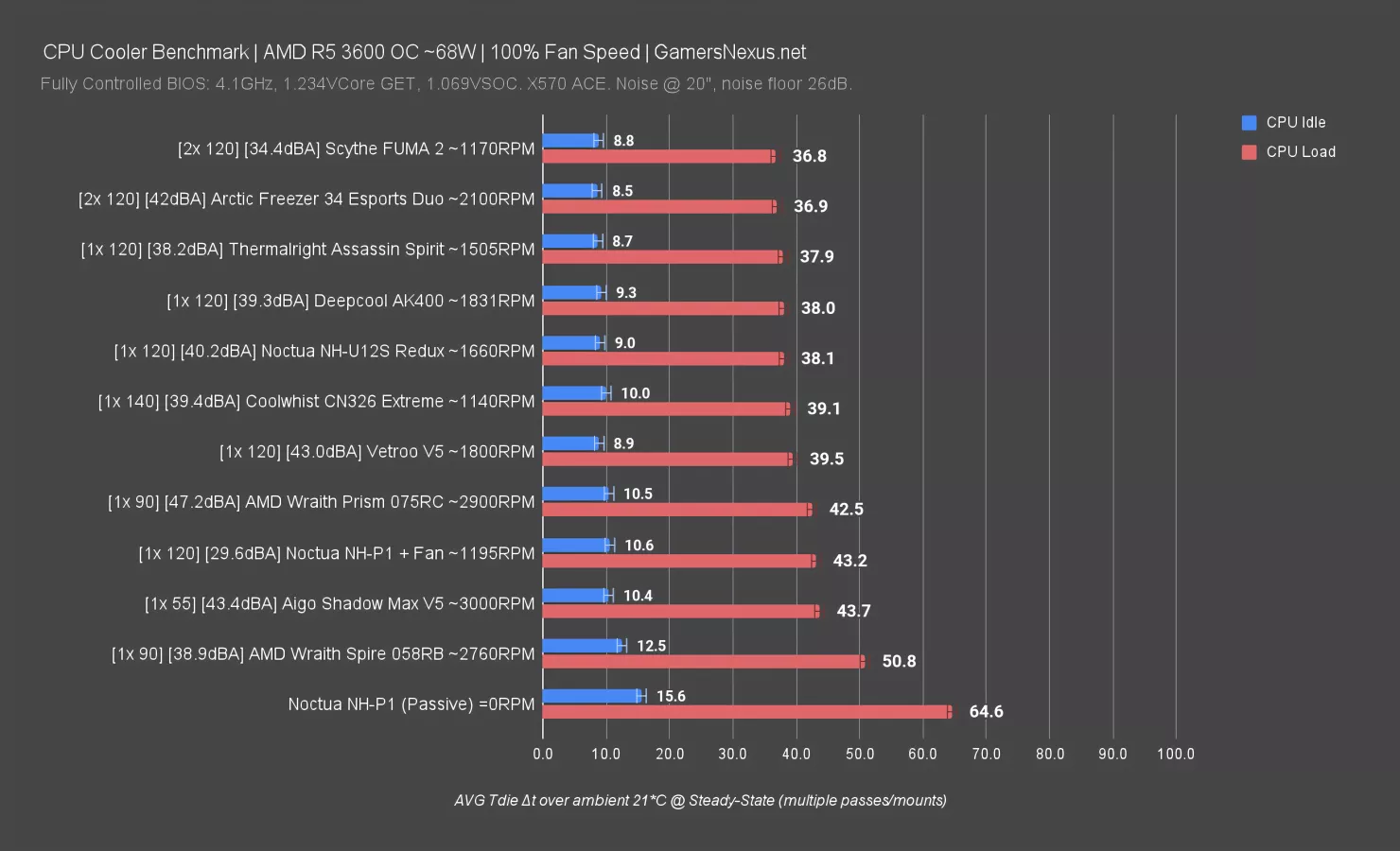
At 100% fan speed, the AK400 comes in at 38 degrees Celsius over ambient at 39dBA when measured with our standardized practices. Once again, this places it within margin of error of the NH-U12S Redux and the Assassin Spirit 120, each of which is within range of inaudible differences. The Freezer 34 is technically ahead here, but it’s also at 42dBA -- so that makes sense. 3dBA is about when people start to notice the volume increase.
Compared to the same-priced Vetroo V5, the AK400 is 2 degrees cooler and 4dBA quieter -- a clear winner, showing some inefficiencies of the V5. All of this places the AK400 among the best coolers we’ve tested for both performance and acoustics with a 68-watt heatload. The Fuma 2 remains the overall victor here, and by an impressive margin -- you just pay for it.
123W 35dBA Normalized Benchmark
Our next benchmark is a 123-watt heatload, representative of something like an AMD R7, Intel i5, and some post-Tau Intel i7 or AMD R9 CPUs. We’ll start this one noise-normalized, but we have 100% numbers next -- including the AK400 with two fans.
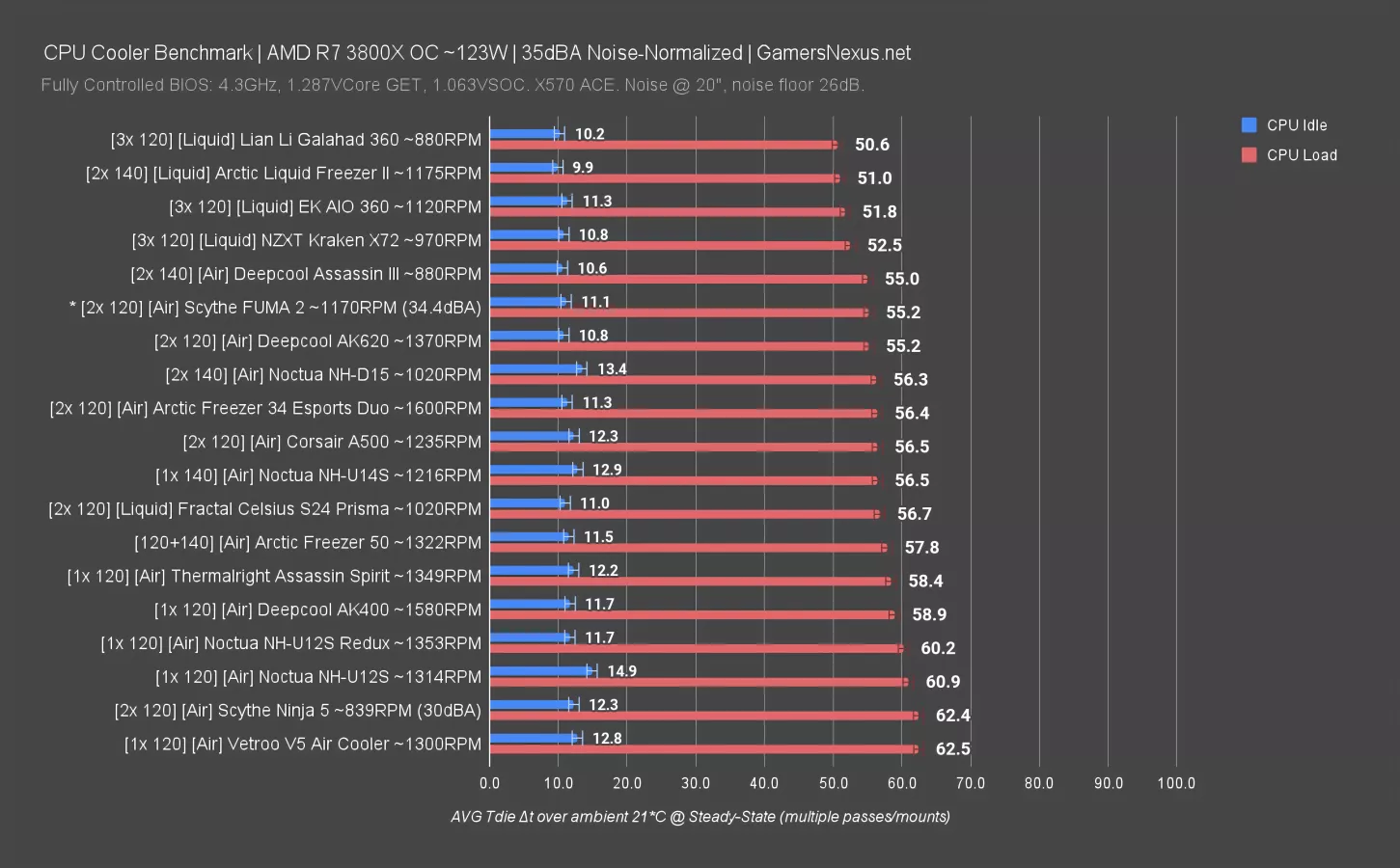
Here’s the chart. With a 123-watt heatload and at 35dBA, the AK400 runs 59 degrees Celsius over ambient. With this heatload, it’s still within the margin of error of the Noctua NH-U12S Redux and the Thermalright Assassin Spirit 120; however, with a higher heatload, the Freezer 34 Duo is able to pull ahead and is now over 2 degrees cooler than the AK400. That distance is widening, allowing the Arctic option an advantage.
The gap between the Vetroo V5 and the AK400 has also grown: the AK400 is now 4 degrees cooler in this test than the V5 -- that’s far better. 4 degrees makes a lot of difference when you’re running warm like this, especially in a case. 123 watts is slightly more than we’d typically recommend for a mid-budget cooler like the AK400, but it’s serviceable and even leaves a bit of room for overclocking or lowering the fan speed.
123W 100% Fan Speed Benchmark
Now, each cooler’s fans are set to 100%.
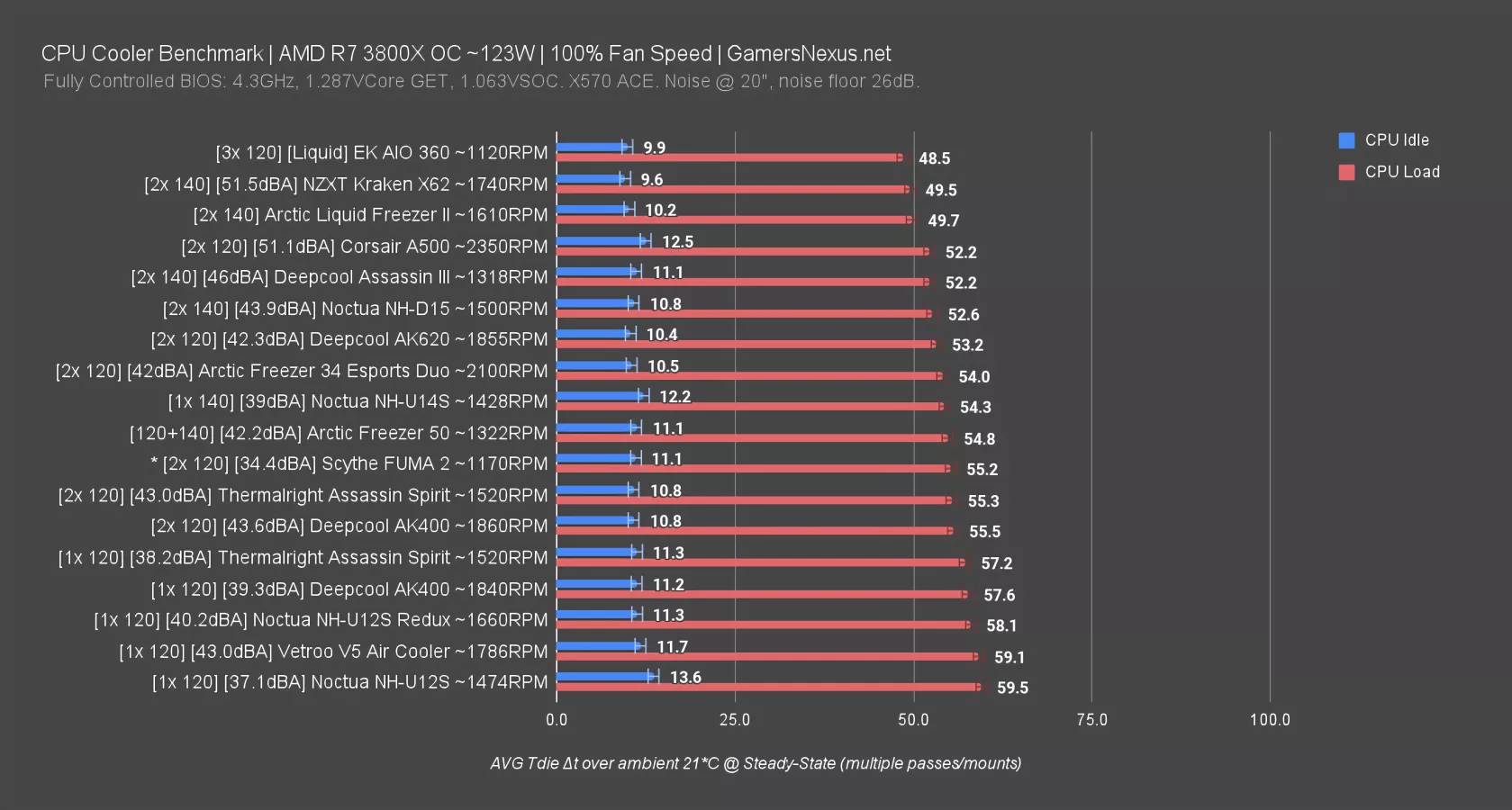
In this benchmark, the DeepCool AK400 runs 58 degrees Celsius over ambient -- it’s barely moved as we were near max already, meaning the AK400 has more limited headroom at the top-end for performance to compensate for higher heat. For some context, 20 to 22 degrees Celsius is room temperature, so it’d be about 80 degrees when factoring in ambient temperature – warm, but not immediately problematic. With two fans, the AK400 ran at 55.5 degrees - so about 2 degrees of improvement but also a louder noise level.
In comparison to other coolers, this puts the AK400 within error of the NH-U12S Redux and the Assassin Spirit 120. Once again, the gap between the Freezer 34 Duo and the AK400 has grown, with the 34 Duo now almost 4 degrees cooler. Considering the Noctua NH-U12S is $15 more than the AK400, and the Thermalright Assassin Spirit 120 is $6 less than the AK400, this places it in a good position for both thermal and acoustic performance compared to similarly priced coolers.
Conclusion & Best CPU Coolers
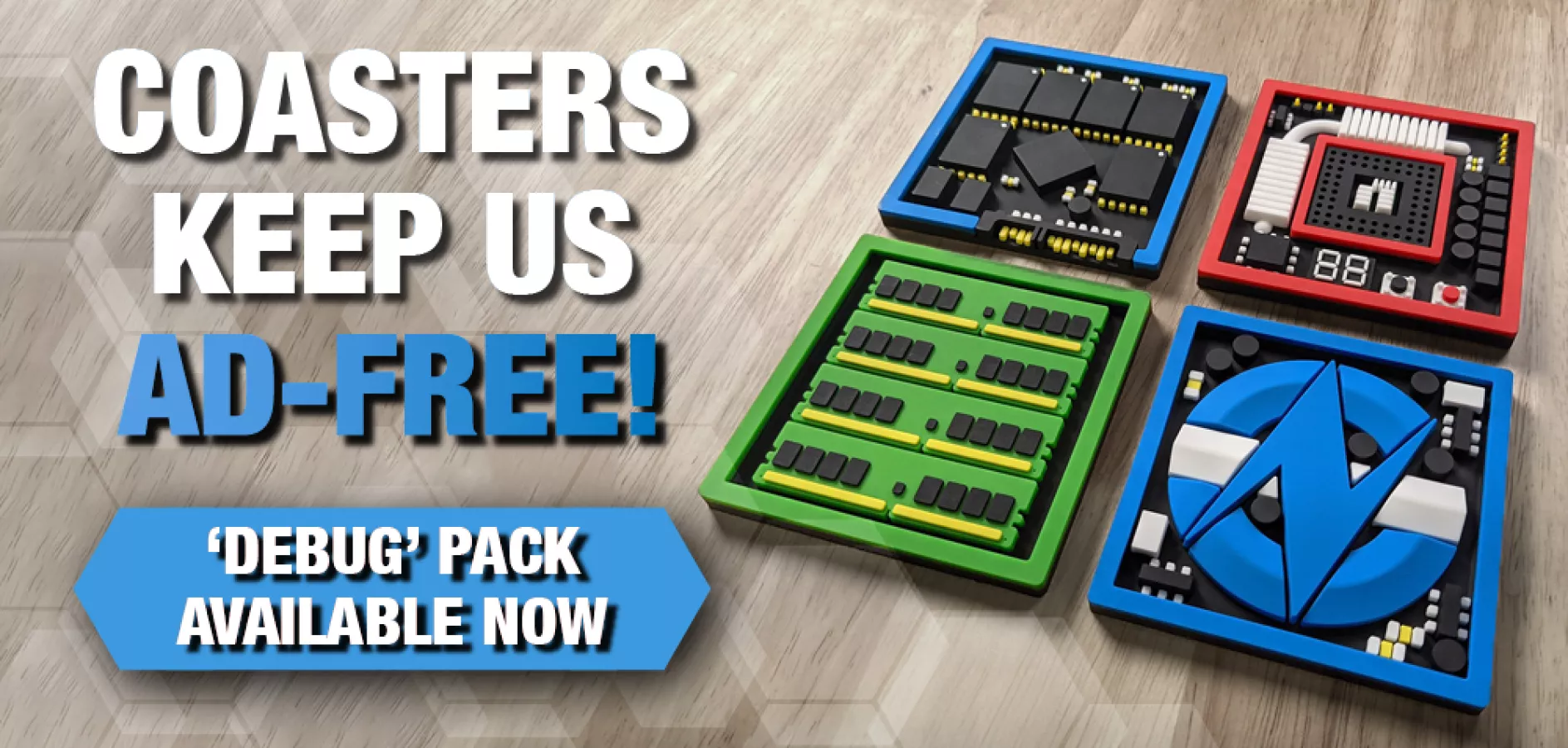
Wrapping this up, just the AK400 standalone is fine at the least and we’re OK with saying that this cooler makes sense at its price point. Its performance is not that impressive to us, it's just kind of standard. This isn't necessarily bad - it is a much better result than us saying the cooler is terrible and that you shouldn't buy it, which we've said about a lot of other coolers. In fact, this is probably most of what we've said for the last 14 years. So it's at least in the “fine” camp, which as it turns out is an exclusive group of products.
The other coolers to consider here are the Arctic Freezer 34 Esports Duo and the Thermalright Assassin Spirit 120. Between these, what you end up with is the Freezer 34 is about $15 more than the AK400 at the time of filming, and thermally that has these coolers about equal. But the Arctic option costs more as it has an extra fan, but the fan isn't doing a whole lot. For a 68W CPU (R5, i5-non k), the Arctic is functionally the same as the AK400.
However once you move up to a higher heat CPU (R7, post-tau expiry i5, and maybe some i7s), the gap between these two widens and it favors the Arctic 34 by a few degrees (up to 4C), which can start to matter at the high end. In the end it's really going to depend on the CPU you’re using. The AK400 is not necessarily a cooler we’d really recommend for that 120W range, but it is capable and as long as you’re using a case that doesn’t suffocate the cooler’s access to air you should be fine, unless you start overclocking.
For the Assassin Spirit, it’s really pretty simple. It is a cheap tower cooler - cheaper than the AK400, when you can find it, and that makes it viable. Part of the reason for the pricing difference is the lack of native LGA 1700 support on the Assassin Spirit, but Thermalright would ship you a bracket if you bought it (however it is not included with the cooler itself).
DeepCool includes all brackets and mounting hardware with the AK400 that are currently relevant and so does Arctic. If you want to go higher end, the Scythe Fuma 2 is a great option for air cooling. There's now a FUMA 3 as well. Liquid cooling of course has its own advantages but you’re basically doubling the price at that point, so we’d say that the Fuma 2 is the one to look at if you are really concerned about acoustics and noise efficient performance. We’ve tested that you can bring the fan speed and noise level down and still achieve a good thermal result, far quieter than what you would achieve for the same thermal performance on a single tower or single fan cooler like the AK400.
Overall, the AK400 is pretty good for DeepCool and it is competitive with the other offerings currently on the market.
That’s it for this one. As always, you can go to the GN Store to get our tool kits, mouse pads, or other products, or you can support us directly and get bonus footage by becoming a Patron at Patreon.
